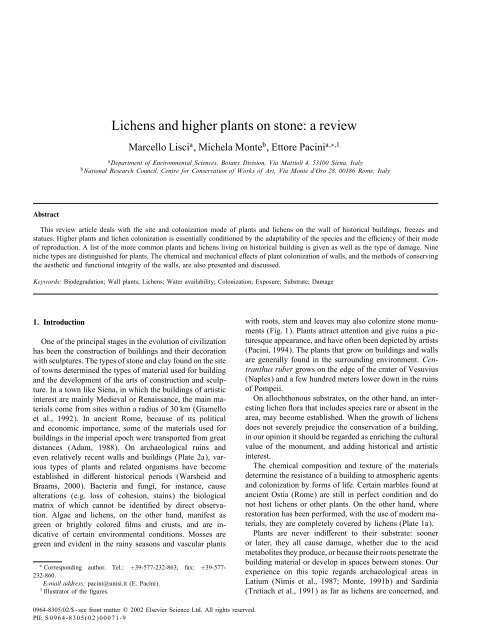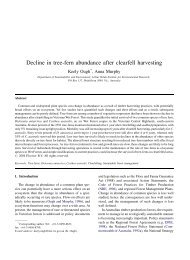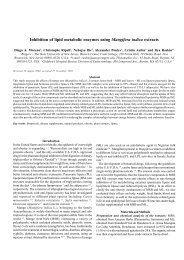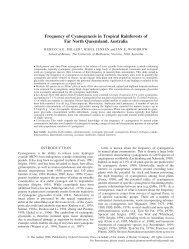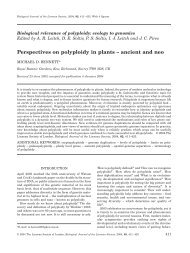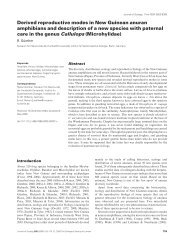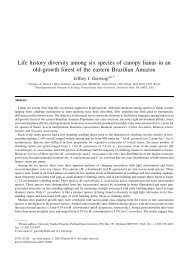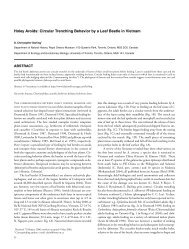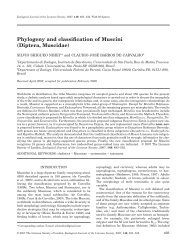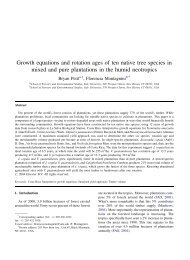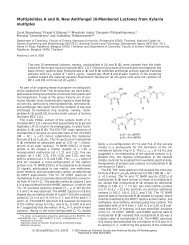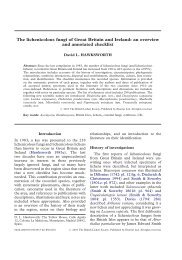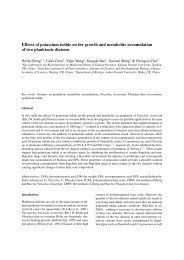Lichens and higher plants on stone: a review - AseanBiodiversity.info
Lichens and higher plants on stone: a review - AseanBiodiversity.info
Lichens and higher plants on stone: a review - AseanBiodiversity.info
You also want an ePaper? Increase the reach of your titles
YUMPU automatically turns print PDFs into web optimized ePapers that Google loves.
Abstract<br />
<str<strong>on</strong>g>Lichens</str<strong>on</strong>g> <str<strong>on</strong>g>and</str<strong>on</strong>g> <str<strong>on</strong>g>higher</str<strong>on</strong>g> <str<strong>on</strong>g>plants</str<strong>on</strong>g> <strong>on</strong> st<strong>on</strong>e: a <strong>review</strong><br />
Marcello Lisci a , Michela M<strong>on</strong>te b , Ettore Pacini a;∗;1<br />
a Department of Envir<strong>on</strong>mental Sciences, Botany Divisi<strong>on</strong>, Via Mattioli 4, 53100 Siena, Italy<br />
b Nati<strong>on</strong>al Research Council, Centre for C<strong>on</strong>servati<strong>on</strong> of Works of Art, Via M<strong>on</strong>te d’Oro 28, 00186 Rome, Italy<br />
This <strong>review</strong> article deals with the site <str<strong>on</strong>g>and</str<strong>on</strong>g> col<strong>on</strong>izati<strong>on</strong> mode of <str<strong>on</strong>g>plants</str<strong>on</strong>g> <str<strong>on</strong>g>and</str<strong>on</strong>g> lichens <strong>on</strong> the wall of historical buildings, freezes <str<strong>on</strong>g>and</str<strong>on</strong>g><br />
statues. Higher <str<strong>on</strong>g>plants</str<strong>on</strong>g> <str<strong>on</strong>g>and</str<strong>on</strong>g> lichen col<strong>on</strong>izati<strong>on</strong> is essentially c<strong>on</strong>diti<strong>on</strong>ed by the adaptability of the species <str<strong>on</strong>g>and</str<strong>on</strong>g> the e ciency of their mode<br />
of reproducti<strong>on</strong>. A list of the more comm<strong>on</strong> <str<strong>on</strong>g>plants</str<strong>on</strong>g> <str<strong>on</strong>g>and</str<strong>on</strong>g> lichens living <strong>on</strong> historical building is given as well as the type of damage. Nine<br />
niche types are distinguished for <str<strong>on</strong>g>plants</str<strong>on</strong>g>. The chemical <str<strong>on</strong>g>and</str<strong>on</strong>g> mechanical e ects of plant col<strong>on</strong>izati<strong>on</strong> of walls, <str<strong>on</strong>g>and</str<strong>on</strong>g> the methods of c<strong>on</strong>serving<br />
the aesthetic <str<strong>on</strong>g>and</str<strong>on</strong>g> functi<strong>on</strong>al integrity of the walls, are also presented <str<strong>on</strong>g>and</str<strong>on</strong>g> discussed.<br />
Keywords: Biodegradati<strong>on</strong>; Wall <str<strong>on</strong>g>plants</str<strong>on</strong>g>; <str<strong>on</strong>g>Lichens</str<strong>on</strong>g>; Water availability; Col<strong>on</strong>izati<strong>on</strong>; Exposure; Substrate; Damage<br />
1. Introducti<strong>on</strong><br />
One of the principal stages in the evoluti<strong>on</strong> of civilizati<strong>on</strong><br />
has been the c<strong>on</strong>structi<strong>on</strong> of buildings <str<strong>on</strong>g>and</str<strong>on</strong>g> their decorati<strong>on</strong><br />
with sculptures. The types of st<strong>on</strong>e <str<strong>on</strong>g>and</str<strong>on</strong>g> clay found <strong>on</strong> the site<br />
of towns determined the types of material used for building<br />
<str<strong>on</strong>g>and</str<strong>on</strong>g> the development of the arts of c<strong>on</strong>structi<strong>on</strong> <str<strong>on</strong>g>and</str<strong>on</strong>g> sculpture.<br />
In a town like Siena, in which the buildings of artistic<br />
interest are mainly Medieval or Renaissance, the main materials<br />
come from sites within a radius of 30 km (Giamello<br />
et al., 1992). In ancient Rome, because of its political<br />
<str<strong>on</strong>g>and</str<strong>on</strong>g> ec<strong>on</strong>omic importance, some of the materials used for<br />
buildings in the imperial epoch were transported from great<br />
distances (Adam, 1988). On archaeological ruins <str<strong>on</strong>g>and</str<strong>on</strong>g><br />
even relatively recent walls <str<strong>on</strong>g>and</str<strong>on</strong>g> buildings (Plate 2a), various<br />
types of <str<strong>on</strong>g>plants</str<strong>on</strong>g> <str<strong>on</strong>g>and</str<strong>on</strong>g> related organisms have become<br />
established in di erent historical periods (Warsheid <str<strong>on</strong>g>and</str<strong>on</strong>g><br />
Braams, 2000). Bacteria <str<strong>on</strong>g>and</str<strong>on</strong>g> fungi, for instance, cause<br />
alterati<strong>on</strong>s (e.g. loss of cohesi<strong>on</strong>, stains) the biological<br />
matrix of which cannot be identi ed by direct observati<strong>on</strong>.<br />
Algae <str<strong>on</strong>g>and</str<strong>on</strong>g> lichens, <strong>on</strong> the other h<str<strong>on</strong>g>and</str<strong>on</strong>g>, manifest as<br />
green or brightly colored lms <str<strong>on</strong>g>and</str<strong>on</strong>g> crusts, <str<strong>on</strong>g>and</str<strong>on</strong>g> are indicative<br />
of certain envir<strong>on</strong>mental c<strong>on</strong>diti<strong>on</strong>s. Mosses are<br />
green <str<strong>on</strong>g>and</str<strong>on</strong>g> evident in the rainy seas<strong>on</strong>s <str<strong>on</strong>g>and</str<strong>on</strong>g> vascular <str<strong>on</strong>g>plants</str<strong>on</strong>g><br />
∗ Corresp<strong>on</strong>ding<br />
232-860.<br />
author. Tel.: +39-577-232-863; fax: +39-577-<br />
E-mail address: pacini@unisi.it (E. Pacini).<br />
1 Illustrator of the gures.<br />
0964-8305/02/$ - see fr<strong>on</strong>t matter ? 2002 Elsevier Science Ltd. All rights reserved.<br />
PII: S 0964-8305(02)00071-9<br />
withroots, stem <str<strong>on</strong>g>and</str<strong>on</strong>g> leaves may also col<strong>on</strong>ize st<strong>on</strong>e m<strong>on</strong>uments<br />
(Fig. 1). Plants attract attenti<strong>on</strong> <str<strong>on</strong>g>and</str<strong>on</strong>g> give ruins a picturesque<br />
appearance, <str<strong>on</strong>g>and</str<strong>on</strong>g> have often been depicted by artists<br />
(Pacini, 1994). The <str<strong>on</strong>g>plants</str<strong>on</strong>g> that grow <strong>on</strong> buildings <str<strong>on</strong>g>and</str<strong>on</strong>g> walls<br />
are generally found in the surrounding envir<strong>on</strong>ment. Centranthus<br />
ruber grows <strong>on</strong> the edge of the crater of Vesuvius<br />
(Naples) <str<strong>on</strong>g>and</str<strong>on</strong>g> a few hundred meters lower down in the ruins<br />
of Pompeii.<br />
On allochth<strong>on</strong>ous substrates, <strong>on</strong> the other h<str<strong>on</strong>g>and</str<strong>on</strong>g>, an interesting<br />
lichen ora that includes species rare or absent in the<br />
area, may become established. When the growth of lichens<br />
does not severely prejudice the c<strong>on</strong>servati<strong>on</strong> of a building,<br />
in our opini<strong>on</strong> it should be regarded as enriching the cultural<br />
value of the m<strong>on</strong>ument, <str<strong>on</strong>g>and</str<strong>on</strong>g> adding historical <str<strong>on</strong>g>and</str<strong>on</strong>g> artistic<br />
interest.<br />
The chemical compositi<strong>on</strong> <str<strong>on</strong>g>and</str<strong>on</strong>g> texture of the materials<br />
determine the resistance of a building to atmospheric agents<br />
<str<strong>on</strong>g>and</str<strong>on</strong>g> col<strong>on</strong>izati<strong>on</strong> by forms of life. Certain marbles found at<br />
ancient Ostia (Rome) are still in perfect c<strong>on</strong>diti<strong>on</strong> <str<strong>on</strong>g>and</str<strong>on</strong>g> do<br />
not host lichens or other <str<strong>on</strong>g>plants</str<strong>on</strong>g>. On the other h<str<strong>on</strong>g>and</str<strong>on</strong>g>, where<br />
restorati<strong>on</strong> has been performed, with the use of modern materials,<br />
they are completely covered by lichens (Plate 1a).<br />
Plants are never indi erent to their substrate: so<strong>on</strong>er<br />
or later, they all cause damage, whether due to the acid<br />
metabolites they produce, or because their roots penetrate the<br />
building material or develop in spaces between st<strong>on</strong>es. Our<br />
experience <strong>on</strong> this topic regards archaeological areas in<br />
Latium (Nimis et al., 1987; M<strong>on</strong>te, 1991b) <str<strong>on</strong>g>and</str<strong>on</strong>g> Sardinia<br />
(Tretiachet al., 1991) as far as lichens are c<strong>on</strong>cerned, <str<strong>on</strong>g>and</str<strong>on</strong>g>
Fig. 1. Block diagram of the fate of a building in relati<strong>on</strong> to human <str<strong>on</strong>g>and</str<strong>on</strong>g><br />
envir<strong>on</strong>mental interventi<strong>on</strong>.<br />
several towns in the south of France, Italy <str<strong>on</strong>g>and</str<strong>on</strong>g> Tunisia as far<br />
as vascular <str<strong>on</strong>g>plants</str<strong>on</strong>g> are c<strong>on</strong>cerned (Lisci <str<strong>on</strong>g>and</str<strong>on</strong>g> Pacini, 1993a,<br />
b). Since these sites range around the Mediterranean, they<br />
re ect the situati<strong>on</strong> of much of the Mediterranean Basin<br />
<str<strong>on</strong>g>and</str<strong>on</strong>g> the m<strong>on</strong>uments of forty centuries of history.<br />
Since lichens <str<strong>on</strong>g>and</str<strong>on</strong>g> vascular <str<strong>on</strong>g>plants</str<strong>on</strong>g> establish in di erent<br />
ways, cause di erent types of damage <str<strong>on</strong>g>and</str<strong>on</strong>g> require di erent<br />
methods of c<strong>on</strong>trol, they are dealt with separately in the<br />
pages that follow.<br />
2. <str<strong>on</strong>g>Lichens</str<strong>on</strong>g><br />
2.1. Types of lichens: structure <str<strong>on</strong>g>and</str<strong>on</strong>g> distributi<strong>on</strong><br />
<str<strong>on</strong>g>Lichens</str<strong>on</strong>g> are fungi (Ascomycetes or seldom Basidiomycetes)<br />
that live in symbiosis with photosynthesizing<br />
organisms (cyanobacteria or green algae) (Hale, 1974).<br />
The partners of the symbiosis, the fungus (mycobi<strong>on</strong>t) <str<strong>on</strong>g>and</str<strong>on</strong>g><br />
the alga (phycobi<strong>on</strong>t), give rise to a simple structure known<br />
as a thallus. The lichen thallus grows where the alga <str<strong>on</strong>g>and</str<strong>on</strong>g><br />
fungus, al<strong>on</strong>e, could not survive. This is why lichens col<strong>on</strong>ize<br />
a large variety of substrates: trees (epiphytes), the<br />
ground (terricolous lichens), st<strong>on</strong>e (epilithic lichens) <str<strong>on</strong>g>and</str<strong>on</strong>g><br />
even glass.<br />
On st<strong>on</strong>e objects, the pH of the substrate performs the<br />
rst selecti<strong>on</strong> of lichen ora. Calcicolous species develop<br />
<strong>on</strong> neutral <str<strong>on</strong>g>and</str<strong>on</strong>g> alkaline substrates <str<strong>on</strong>g>and</str<strong>on</strong>g> silicicolous species <strong>on</strong><br />
acid substrates. The forms of growth of thalli that col<strong>on</strong>ize<br />
st<strong>on</strong>e (Fig. 2) may be:<br />
• crust-like: the thallus adheres closely to the surface <str<strong>on</strong>g>and</str<strong>on</strong>g><br />
penetrates it, forming a kind of crust;<br />
• foliose: the thallus penetrates the substrate <strong>on</strong>ly with its<br />
rhizines (thread-like anchorage devices) <str<strong>on</strong>g>and</str<strong>on</strong>g> can easily<br />
be removed from the surface of the st<strong>on</strong>e;<br />
• fruticose: the thallus develops in three dimensi<strong>on</strong>s, taking<br />
<strong>on</strong> a hanging, rami ed form, generally anchored to the<br />
substrate by a type of butt<strong>on</strong>;<br />
• endolithic: these <strong>on</strong>ly occur <strong>on</strong> calcareous st<strong>on</strong>e: the thallus<br />
is completely immersed in the substrate <str<strong>on</strong>g>and</str<strong>on</strong>g> is di cult<br />
to distinguish, being white in color. It is generally noticed<br />
when it reproduces because the fruiting bodies emerge<br />
from the st<strong>on</strong>e, leaving behind small pits.<br />
Lichen reproducti<strong>on</strong> occurs by germinati<strong>on</strong> of spores or<br />
multiplicati<strong>on</strong> of the cells of the soredia <str<strong>on</strong>g>and</str<strong>on</strong>g> isidia. Spores<br />
arising from fruiting bodies (Fig. 3c) are formed by sexual<br />
reproducti<strong>on</strong> of the fungal partner <strong>on</strong>ly. Dispersed in the<br />
envir<strong>on</strong>ment, they rec<strong>on</strong>stitute a symbiosis if they encounter<br />
a suitable phycobi<strong>on</strong>t. The soredia, balls of fungal laments<br />
around an algal cell (Fig. 3a), <str<strong>on</strong>g>and</str<strong>on</strong>g> isidia, appendages of the<br />
upper cortex of the thallus that envelop several algae (Fig.<br />
3b), are structures of vegetative reproducti<strong>on</strong> in which both<br />
partners of the symbiosis take part.<br />
The reproductive structures are dispersed in the atmosphere<br />
by wind or transported by birds <str<strong>on</strong>g>and</str<strong>on</strong>g> insects. If they<br />
fall into cracks, pores or cavities that retain water, new<br />
growthmay arise (Garty, 1992).<br />
It is not a coincidence that di erent types of lichens<br />
grow <strong>on</strong> m<strong>on</strong>uments. Eachspecies can <strong>on</strong>ly live in a de -<br />
nite range of pH, humidity, luminosity <str<strong>on</strong>g>and</str<strong>on</strong>g> nitrogen supply;<br />
some species can <strong>on</strong>ly live in a very narrow range of values<br />
(stenoic) whereas other species grow over a wider interval<br />
of c<strong>on</strong>diti<strong>on</strong>s (euroic).<br />
Wirth (1980) devised indices of pH, hygrophytism,<br />
nitrophytism <str<strong>on</strong>g>and</str<strong>on</strong>g> photophytism <strong>on</strong> the basis of detailed<br />
knowledge of the ecology of the various species <str<strong>on</strong>g>and</str<strong>on</strong>g> their<br />
relati<strong>on</strong>ships. These indices can be used to characterize<br />
the pH range of substrates, their humidity, solar radiati<strong>on</strong><br />
<str<strong>on</strong>g>and</str<strong>on</strong>g> eutrophicati<strong>on</strong> <strong>on</strong> the basis of the species identi ed<br />
(M<strong>on</strong>te, 1991a). This <strong>info</strong>rmati<strong>on</strong> is useful for establishing<br />
existing gradients of humidity values <str<strong>on</strong>g>and</str<strong>on</strong>g> solar radiati<strong>on</strong> so<br />
that alterati<strong>on</strong>s can be interpreted (M<strong>on</strong>te, 1991b; Corball,<br />
et al., 2001).<br />
<str<strong>on</strong>g>Lichens</str<strong>on</strong>g> behave as natural sensors of atmospheric polluti<strong>on</strong><br />
because the symbiosis between fungus <str<strong>on</strong>g>and</str<strong>on</strong>g> alga has its<br />
weak points. Highpolluti<strong>on</strong>, particularly by sulfur dioxide,<br />
damages the lichen thallus, rst leading to retarded growth<br />
<str<strong>on</strong>g>and</str<strong>on</strong>g> then to death. The number of species tends to decrease<br />
drastically from the periphery to the center of urbanized areas,<br />
with a decrease in the number of species <str<strong>on</strong>g>and</str<strong>on</strong>g> of the<br />
surface area col<strong>on</strong>ized (Seaward, 1976).
Plate 1. (a) Statue in archaeological site in ancient Ostia. The lichens <strong>on</strong>ly grow where restorati<strong>on</strong> has been performed. (b) Orvieto Cathedral with<br />
lichens growing al<strong>on</strong>g paths of water run-o <str<strong>on</strong>g>and</str<strong>on</strong>g> obscuring the black <str<strong>on</strong>g>and</str<strong>on</strong>g> white b<str<strong>on</strong>g>and</str<strong>on</strong>g>s. (c) Column of north portal of Orvieto Cathedral. The lichen<br />
Dirina massiliensis causes pitting that is visible when the thalli drop o . (d) Typical Sardinian “nuraghe”. Exposure plays a fundamental role in lichen<br />
col<strong>on</strong>izati<strong>on</strong>. Note also <str<strong>on</strong>g>plants</str<strong>on</strong>g> growing between st<strong>on</strong>es.<br />
2.2. <str<strong>on</strong>g>Lichens</str<strong>on</strong>g> as agents of damage<br />
In the past, the role of lichens in the break-down of<br />
st<strong>on</strong>e was muchdiscussed. They were regarded as primary<br />
col<strong>on</strong>izers <str<strong>on</strong>g>and</str<strong>on</strong>g> believed to precede any other form of life.<br />
They were thought capable of col<strong>on</strong>izing surfaces that<br />
had not underg<strong>on</strong>e any previous alterati<strong>on</strong>, whether<br />
chemical or physical.
Fig. 2. Di erent forms of lichen growth <strong>on</strong> st<strong>on</strong>e: (a) crust-like lichen;<br />
(b) foliose lichen; (c) fruticose lichen; (d) endolithic lichen.<br />
According to Savoye <str<strong>on</strong>g>and</str<strong>on</strong>g> Lallemant (1980), however,<br />
lichens establish <strong>on</strong> a substrate after it has been partly transformed<br />
by substances in the air <str<strong>on</strong>g>and</str<strong>on</strong>g> then by bacteria. This<br />
hypothesis seems veri ed by the fact that lichens grow more<br />
readily <strong>on</strong> archaeological ruins <strong>on</strong> which mould facilitates<br />
bacterial growth <str<strong>on</strong>g>and</str<strong>on</strong>g> <strong>on</strong> st<strong>on</strong>e surfaces that have become<br />
porous.<br />
Although the role of primary col<strong>on</strong>izer seems doubtful,<br />
lichens, especially the crust-like <str<strong>on</strong>g>and</str<strong>on</strong>g> endolithic forms, nevertheless<br />
transform st<strong>on</strong>e substrates, causing de-cohesi<strong>on</strong><br />
<str<strong>on</strong>g>and</str<strong>on</strong>g> biocorrosi<strong>on</strong>. Certain alterati<strong>on</strong>s were dem<strong>on</strong>strated by<br />
Gehrmann et al. (1988) to be typical of crust-like lichens.<br />
Mechanical damage is due, in the rst place, to penetrati<strong>on</strong><br />
of the substrate by the hyphae (Fig. 2). The depth to which<br />
the thallus penetrates depends <strong>on</strong> the lichen species <str<strong>on</strong>g>and</str<strong>on</strong>g> the<br />
nature of the substrate. A study by Syers (1964) showed that<br />
penetrati<strong>on</strong> may range from a minimum of 0:3 mm to a maximum<br />
of 16 mm. Loss of cohesi<strong>on</strong> may also occur as a result<br />
of the expansi<strong>on</strong> <str<strong>on</strong>g>and</str<strong>on</strong>g> c<strong>on</strong>tracti<strong>on</strong> of the thallus as it undergoes<br />
uctuati<strong>on</strong>s in water supply (Fry, 1924; 1927). <str<strong>on</strong>g>Lichens</str<strong>on</strong>g><br />
may also damage a substrate by means of acid substances<br />
suchas carb<strong>on</strong> dioxide, lichenic acids <str<strong>on</strong>g>and</str<strong>on</strong>g> oxalic acid. Carb<strong>on</strong><br />
dioxide, produced by respirati<strong>on</strong> of the thallus, dissolves<br />
calcareous rocks in the presence of moisture, leading to the<br />
formati<strong>on</strong> of soluble bicarb<strong>on</strong>ates that may be washed away<br />
or cause encrustati<strong>on</strong>. This type of alterati<strong>on</strong> is characteristic<br />
of endolithic lichens (Syers <str<strong>on</strong>g>and</str<strong>on</strong>g> Isk<str<strong>on</strong>g>and</str<strong>on</strong>g>er, 1973). A large<br />
variety of substances produced by the lichen symbiosis are<br />
grouped under the name of lichenic acids. Shatz (1963) <str<strong>on</strong>g>and</str<strong>on</strong>g><br />
later Isk<str<strong>on</strong>g>and</str<strong>on</strong>g>er <str<strong>on</strong>g>and</str<strong>on</strong>g> Syers (1972) showed that some of these<br />
substances are chelating agents <str<strong>on</strong>g>and</str<strong>on</strong>g> in aqueous suspensi<strong>on</strong>s<br />
of basalt, granite <str<strong>on</strong>g>and</str<strong>on</strong>g> biotite, form metal complexes of low<br />
solubility. Ascaso et al. (1976) detected mineral complexes<br />
that were not present <strong>on</strong> the naked rock surface, at the<br />
lichen-substrate interface. Fragments of thallus incubated in<br />
suspensi<strong>on</strong>s of the same pulverized rock formed minerals<br />
similar to those found at the interface. Further c<strong>on</strong> rmati<strong>on</strong><br />
of the capacity of lichenic acids to produce alterati<strong>on</strong> was<br />
provided by Galvan et al. (1981) <str<strong>on</strong>g>and</str<strong>on</strong>g> this enabled a series<br />
of minerals associated with the presence of lichens to be<br />
identi ed.<br />
It has l<strong>on</strong>g been known that lichens produce oxalic acid<br />
(Bracc<strong>on</strong>ot, 1825). Unlike lichenic acids, oxalic acid is not<br />
an exclusive product of lichens. It is also found in fungi as<br />
a nal product (Chiari et al., 1989) <str<strong>on</strong>g>and</str<strong>on</strong>g> is comm<strong>on</strong> in all<br />
living organisms as an intermediate of the Krebs cycle. It<br />
reacts withsubstrate minerals to form various oxalates, according<br />
to the cati<strong>on</strong>s available <str<strong>on</strong>g>and</str<strong>on</strong>g> the state of hydrati<strong>on</strong><br />
of the rock (Corball et al., 2001). Calcium oxalate is by<br />
far the most comm<strong>on</strong> of these; usually it crystallizes as a<br />
m<strong>on</strong>ohydrate (whewellite), but may also occur in the dihydrated<br />
form (weddelite) (J<strong>on</strong>es et al., 1980). Due to their low<br />
solubility, oxalates tend to accumulate inside the thallus (Enderman<br />
et al., 1977), or at the lichen-substrate interface (Ascaso<br />
et al., 1976), sometimes forming a crystalline layer <strong>on</strong><br />
the upper surface of the thallus (Jacks<strong>on</strong>, 1981). Del M<strong>on</strong>te<br />
<str<strong>on</strong>g>and</str<strong>on</strong>g> Sabbi<strong>on</strong>i (1987) suggested that oxalate patinas <strong>on</strong> ancient<br />
m<strong>on</strong>uments (Guidobaldi et al., 1984) are the result of<br />
the metabolic activity of lichens of the past that have disappeared<br />
from towns due to polluti<strong>on</strong>. This hypothesis caused<br />
much c<strong>on</strong>troversy <str<strong>on</strong>g>and</str<strong>on</strong>g> stimulated research which, far from<br />
settling the dispute about the origin of the patinas, nevertheless<br />
revealed that they can protect the underlying st<strong>on</strong>e by<br />
virtue of their low solubility (Aless<str<strong>on</strong>g>and</str<strong>on</strong>g>rini, 1989).<br />
2.3. Recogniti<strong>on</strong> of biodeteriorati<strong>on</strong> of a material<br />
As for <str<strong>on</strong>g>plants</str<strong>on</strong>g>, the identi cati<strong>on</strong> of lichens is based <strong>on</strong><br />
the diagnostic characters of the di erent species. The main<br />
lichen characters used are form of growth, color, thallus<br />
size, surface structures (isidia, soredia <str<strong>on</strong>g>and</str<strong>on</strong>g> so forth), fruiting<br />
bodies, number <str<strong>on</strong>g>and</str<strong>on</strong>g> form of spores, <str<strong>on</strong>g>and</str<strong>on</strong>g> speci c substances<br />
in the thallus. Identi cati<strong>on</strong> is generally performed in<br />
situ. When microscopic observati<strong>on</strong> is necessary, fragments<br />
of thallus <str<strong>on</strong>g>and</str<strong>on</strong>g> fruiting bodies are removed with a scalpel<br />
without damaging the rock surface. In the laboratory, special<br />
reagents are used that give a color reacti<strong>on</strong> with speci c<br />
lichen chemicals.<br />
To study the distributi<strong>on</strong> of lichens over vast areas, phytosociological<br />
surveys can be performed according to the<br />
method of Braun-Blanquet (1964). Each survey c<strong>on</strong>sists of<br />
a list of species identi ed in a de ned area. Eachspecies is<br />
assigned a substrate cover value in a scale of several classes.<br />
The type of substrate, its inclinati<strong>on</strong> <str<strong>on</strong>g>and</str<strong>on</strong>g> aspect are noted for<br />
eachsurvey. The data is classi ed <str<strong>on</strong>g>and</str<strong>on</strong>g> ordered to identify<br />
clusters <str<strong>on</strong>g>and</str<strong>on</strong>g> relati<strong>on</strong>ships between groups by the method of<br />
Wildi <str<strong>on</strong>g>and</str<strong>on</strong>g> Orloci (1988). The ecological characterizati<strong>on</strong> of<br />
the various groups can be performed by associating the indices<br />
of pH, nitrophytism, hygrophytism <str<strong>on</strong>g>and</str<strong>on</strong>g> photophytism<br />
proposed by Wirth(1980).<br />
Deteriorati<strong>on</strong> can be observed at the rock-lichen interface<br />
by combined methods such as the study of translucent or
Fig. 3. Di erent structures of vegetative (a,b) <str<strong>on</strong>g>and</str<strong>on</strong>g> sexual (c) reproducti<strong>on</strong> of lichens: (a) soredium; (b) isidium; (c) spores.<br />
thin secti<strong>on</strong>s, X-ray di racti<strong>on</strong> <str<strong>on</strong>g>and</str<strong>on</strong>g> scanning electr<strong>on</strong> microscope<br />
(SEM) observati<strong>on</strong> using a microprobe. Salvadori <str<strong>on</strong>g>and</str<strong>on</strong>g><br />
Lazzarini (1991) dem<strong>on</strong>strated oxalates by polarizati<strong>on</strong> microscope<br />
observati<strong>on</strong> of thin secti<strong>on</strong>s. Modenesi <str<strong>on</strong>g>and</str<strong>on</strong>g> Lajolo<br />
(1988) proposed various preparati<strong>on</strong> techniques for samples<br />
of marble col<strong>on</strong>ized by Aspicilia c<strong>on</strong>torta for polarizati<strong>on</strong><br />
microscope <str<strong>on</strong>g>and</str<strong>on</strong>g> SEM observati<strong>on</strong>; these methods involved<br />
removing calcium carb<strong>on</strong>ate by placing the samples in<br />
dilute soluti<strong>on</strong>s of hydrochloric or acetic acid.<br />
2.4. Organisms involved <str<strong>on</strong>g>and</str<strong>on</strong>g> examples of biological attack<br />
Like other species of animals <str<strong>on</strong>g>and</str<strong>on</strong>g> <str<strong>on</strong>g>plants</str<strong>on</strong>g>, lichens have a<br />
geographic distributi<strong>on</strong>, the range of which depends <strong>on</strong> the<br />
adaptability of eachsymbiotic organism. The species involved<br />
therefore vary from place to place in relati<strong>on</strong> to climate<br />
<str<strong>on</strong>g>and</str<strong>on</strong>g> other envir<strong>on</strong>mental factors. Here we give some<br />
examples of lichens growing <strong>on</strong> m<strong>on</strong>uments, their e ect<br />
<strong>on</strong> the substrate <str<strong>on</strong>g>and</str<strong>on</strong>g> the envir<strong>on</strong>mental characteristics that<br />
in uence col<strong>on</strong>izati<strong>on</strong>.<br />
Orvieto Cathedral is extensively col<strong>on</strong>ized by lichens<br />
around the tympanum of the main facade (Nimis <str<strong>on</strong>g>and</str<strong>on</strong>g><br />
M<strong>on</strong>te, 1988). One reas<strong>on</strong> for lichen growth is enrichment<br />
of the substrate by the excrement of birds that roost <str<strong>on</strong>g>higher</str<strong>on</strong>g><br />
up. Nitrates are washed over the st<strong>on</strong>e by rain. On the north<br />
side, moreover, moister c<strong>on</strong>diti<strong>on</strong>s due to c<strong>on</strong>densati<strong>on</strong><br />
have favored lichen col<strong>on</strong>izati<strong>on</strong> of vast areas, even by n<strong>on</strong>nitrophiles.<br />
Unaesthetic color changes <strong>on</strong> the dark basalt<br />
b<str<strong>on</strong>g>and</str<strong>on</strong>g>s of the cathedral are due to the growth of pale-colored<br />
lichens (Haematomma ochroleucum var. porphyrium <str<strong>on</strong>g>and</str<strong>on</strong>g><br />
Tephromela atra) (Plate 1b). Seaward (1988) showed the<br />
di erent roles played by various lichen species in the deteriorati<strong>on</strong><br />
of st<strong>on</strong>e m<strong>on</strong>uments in Rome. The sporadic growth<br />
of Lecanora muralis has caused mechanical decay of the<br />
substrate. Species suchas Lecanora dispersa, C<str<strong>on</strong>g>and</str<strong>on</strong>g>elariella<br />
vitellina <str<strong>on</strong>g>and</str<strong>on</strong>g> Lecidea fuscoatra that also have signi cant<br />
cover, do not cause evident modi cati<strong>on</strong> of the substrate.<br />
Nimis <str<strong>on</strong>g>and</str<strong>on</strong>g> Zappa (1988) studied the col<strong>on</strong>izati<strong>on</strong> of<br />
st<strong>on</strong>e by endolithic calcicolous lichens such as Bagliet-<br />
toa parmigerella, Bagliettoa parmigera <str<strong>on</strong>g>and</str<strong>on</strong>g> Caloplaca<br />
ochracea <str<strong>on</strong>g>and</str<strong>on</strong>g> showed that they cause dissoluti<strong>on</strong>.<br />
In a comparative study of lichen ora growing <strong>on</strong> the<br />
buildings of Salento, Seaward et al. (1989) observed that the<br />
species were di erent from those found in the surrounding<br />
natural envir<strong>on</strong>ment. In this case, factors associated with<br />
human activities were more important than natural <strong>on</strong>es in<br />
determining lichen vegetati<strong>on</strong>.<br />
Nimis et al. (1987) in Latium <str<strong>on</strong>g>and</str<strong>on</strong>g> Tretiachet al. (1991)<br />
in Sardinia identi ed about 300 di erent species <strong>on</strong> archaeological<br />
remains. On close, microcrystalline calcareous rock<br />
exposed to the sun, the main species were Caloplaca aurantia,<br />
Caloplaca avescens, Aspicilia calcarea, Aspicilia<br />
radiosa <str<strong>on</strong>g>and</str<strong>on</strong>g> Verrucaria nigrescens. On porous calcareous<br />
rock exposed to the north, in shaded positi<strong>on</strong>s or near the<br />
soil, the main species were Bagliettoa parmigera, Placintium<br />
nigrum <str<strong>on</strong>g>and</str<strong>on</strong>g> Caloplaca ochracea. On vertical brick<br />
walls of the Capitolium (ancient Ostia) exposed to the<br />
north, Dirina massiliensis, Dirina stenhammari, Lecidella<br />
carpathica, Roccella phycopsis prevailed. The cover of<br />
the latter was greater several meters above ground level<br />
where the substrate is exposed to moist winds from the sea.<br />
Dirina massiliensis was also found <strong>on</strong> the marble portal<br />
of the Cathedral of Orvieto, where it is causing corrosi<strong>on</strong><br />
(Plate 1c). Seaward <str<strong>on</strong>g>and</str<strong>on</strong>g> Giacobini (1989) have c<strong>on</strong> rmed<br />
the corrosive e ect of Dirina massiliensis growing <strong>on</strong> frescoes<br />
of Palazzo Farnese at Caprarola. On granite, trachyte,<br />
basalt <str<strong>on</strong>g>and</str<strong>on</strong>g> tu “nuraghi” of NW Sardinia (Plate 1d), the<br />
distributi<strong>on</strong> <str<strong>on</strong>g>and</str<strong>on</strong>g> reproductive <str<strong>on</strong>g>and</str<strong>on</strong>g> propagati<strong>on</strong> strategies of<br />
the species are in uenced by solar radiati<strong>on</strong> <str<strong>on</strong>g>and</str<strong>on</strong>g> humidity<br />
(M<strong>on</strong>te, 1993). Fig. 4 summarizes the dispositi<strong>on</strong> of different<br />
lichen communities <strong>on</strong> a typical “nuraghe” in relati<strong>on</strong><br />
to exposure. The characteristic species of each community<br />
are indicated.<br />
Deruelle et al. (1979) examined lichens <strong>on</strong> the Basilica<br />
of Notre-Dame de l’Epine, in the country 8 km from<br />
Chal<strong>on</strong>s-sur-Marne. On the west wall, unsightly populati<strong>on</strong>s<br />
of green <str<strong>on</strong>g>and</str<strong>on</strong>g> orange lichens had become established.<br />
Identi cati<strong>on</strong> of the nitrophiles C<str<strong>on</strong>g>and</str<strong>on</strong>g>elariella medians,
Fig. 4. Distributi<strong>on</strong> of 12 lichen communities <strong>on</strong> acid rock of a Sardinian “nuraghe”. A: upper part of the nuraghe; B: lower part of the nuraghe.<br />
Phaeophyscia orbicularis, Xanthoria c<str<strong>on</strong>g>and</str<strong>on</strong>g>elaria <str<strong>on</strong>g>and</str<strong>on</strong>g> Caloplaca<br />
citrina showed that nutrient enrichment of the st<strong>on</strong>e<br />
substrate had caused lichen growth. The nitrates were attributed<br />
to fertilizers dusted <strong>on</strong> crops in the surrounding elds.<br />
On the tower of the Cathedral of Seville, la Giralda, calcicolous<br />
species (almost all crust-like <str<strong>on</strong>g>and</str<strong>on</strong>g> epilithic) have<br />
been identi ed. Their growthis associated withbird excrement.<br />
These species usually live <strong>on</strong> deteriorated calcareous<br />
substrates (Saiz-Jimenez, 1981).<br />
On the pavement mosaics of the Romanesque town of<br />
Italica (Seville), the tesserae <str<strong>on</strong>g>and</str<strong>on</strong>g> mortar were attacked by<br />
Aspicilia radiosa, Aspicilia ho mannii <str<strong>on</strong>g>and</str<strong>on</strong>g> several species<br />
of the genus Caloplaca (Garcia Rowe <str<strong>on</strong>g>and</str<strong>on</strong>g> Saiz-Jimenez,<br />
1988).<br />
2.5. Methods of preventi<strong>on</strong> <str<strong>on</strong>g>and</str<strong>on</strong>g> c<strong>on</strong>trol<br />
The opportunity of removing lichens from st<strong>on</strong>e substrates<br />
must be evaluated case by case, since the damage caused<br />
by eachspecies is di erent. The rst step is to identify <str<strong>on</strong>g>and</str<strong>on</strong>g><br />
perform an ecological characterizati<strong>on</strong> of the species so as to<br />
be able to choose a speci c agent to eliminate the lichen <str<strong>on</strong>g>and</str<strong>on</strong>g><br />
the cause of its growth. Foliose <str<strong>on</strong>g>and</str<strong>on</strong>g> fruticose lichens have<br />
very di erent sensitivities to chemical agents (Giacobini et<br />
al., 1979). If the factors favoring lichen growth are known,<br />
preventive measures can be suggested to halt or slow down<br />
processes of col<strong>on</strong>izati<strong>on</strong>.<br />
Before removing nitrophilic species, which are relatively<br />
fast-growing <str<strong>on</strong>g>and</str<strong>on</strong>g> cause substantial damage, it is advisable<br />
to nd a way of avoiding nitrate enrichment of the st<strong>on</strong>e<br />
surfaces. This can be achieved by c<strong>on</strong>trolling the bird populati<strong>on</strong>s<br />
of towns, the use of fertilizers in nearby elds,<br />
<str<strong>on</strong>g>and</str<strong>on</strong>g> water ow over the surfaces. Water run-o is generally<br />
avoided by sheltering or re-directing the water (Nimis <str<strong>on</strong>g>and</str<strong>on</strong>g><br />
M<strong>on</strong>te, 1988).<br />
For surfaces col<strong>on</strong>ized by endolithic lichens, Nimis <str<strong>on</strong>g>and</str<strong>on</strong>g><br />
Zappa (1988) advise against eliminati<strong>on</strong>, as degenerati<strong>on</strong> of<br />
the thallus leaves the surface porous <str<strong>on</strong>g>and</str<strong>on</strong>g> more vulnerable<br />
to envir<strong>on</strong>mental acids, whereas the damage caused by the<br />
lichens is limited due to their extremely slow growth.<br />
In the past, normal restorati<strong>on</strong> practice involved the mechanical<br />
removal of the lichen thalli. Today this is d<strong>on</strong>e<br />
<strong>on</strong>ly for foliose <str<strong>on</strong>g>and</str<strong>on</strong>g> fruticose lichens since they do not<br />
adhere str<strong>on</strong>gly to the substrate. Mechanical removal of<br />
crust-like lichens, the thallus of which penetrates deeply<br />
into the st<strong>on</strong>e, requires the use of hard brushes <str<strong>on</strong>g>and</str<strong>on</strong>g> much<br />
washing with water <str<strong>on</strong>g>and</str<strong>on</strong>g> detergents. This process disperses<br />
the spores <str<strong>on</strong>g>and</str<strong>on</strong>g> causes much st<strong>on</strong>e to be lost. To avoid these<br />
problems, Clarke (1976) advised applying an amm<strong>on</strong>ium<br />
hydroxide soluti<strong>on</strong> to kill the thalli <str<strong>on</strong>g>and</str<strong>on</strong>g> loosen them, before<br />
mechanical removal. Nimis et al. (1987) advised against<br />
mechanical removal of thalli with soredia in order to avoid<br />
dispersal of these asexual reproductive structures <str<strong>on</strong>g>and</str<strong>on</strong>g> spread<br />
of the lichens.<br />
<str<strong>on</strong>g>Lichens</str<strong>on</strong>g> are generally removed by applicati<strong>on</strong> of chemical<br />
products (see Appendix A) which may be combined<br />
with mechanical methods. A large variety of biocides that<br />
damage either the phycobi<strong>on</strong>t (algicides) or the mycobi<strong>on</strong>t<br />
(fungicides) are available (Lloyd, 1971). The most<br />
important parameters to c<strong>on</strong>sider in the choice of products<br />
to use for restorati<strong>on</strong> are e cacy, n<strong>on</strong>reactivity with<br />
the substrate <str<strong>on</strong>g>and</str<strong>on</strong>g> toxicological characteristics. E cacy<br />
against the lichen should be a maximum at the minimum<br />
dose. The biocides should be of broad spectrum <str<strong>on</strong>g>and</str<strong>on</strong>g> have<br />
a l<strong>on</strong>g-lasting e ect. Chemical soluti<strong>on</strong>s should have a<br />
neutral pH to avoid corroding the st<strong>on</strong>e <str<strong>on</strong>g>and</str<strong>on</strong>g> interfering<br />
with any soluble salts (Richards<strong>on</strong>, 1976). They should<br />
not cause changes in color, loss of translucence, whitening<br />
or increased re ectance. Richards<strong>on</strong> (1976, 1987) advises<br />
against the use of copper compounds <str<strong>on</strong>g>and</str<strong>on</strong>g> phenols because<br />
they color the substrate, <str<strong>on</strong>g>and</str<strong>on</strong>g> of borates that favor the formati<strong>on</strong><br />
of soluble salts. For vast areas it is preferable to<br />
use low toxicity products (Class III or IV, expressed as<br />
LD50 or LC50) so as to avoid c<strong>on</strong>taminati<strong>on</strong> of the envir<strong>on</strong>ment<br />
<str<strong>on</strong>g>and</str<strong>on</strong>g> pois<strong>on</strong>ing of the operators. Biocides may be<br />
applied by spraying, brushing or pasting. Spraying should
e avoided <strong>on</strong> windy days <str<strong>on</strong>g>and</str<strong>on</strong>g> brushing when the surface<br />
is friable. Paste is used when the agent must be kept in<br />
c<strong>on</strong>tact with the surface for a l<strong>on</strong>ger period. The materials<br />
usually used for pasting are paper pulp, rice paper, cott<strong>on</strong><br />
wool <str<strong>on</strong>g>and</str<strong>on</strong>g> substances suchas carboxymethylcellulose (Mora<br />
<str<strong>on</strong>g>and</str<strong>on</strong>g> Mora, 1972). Richards<strong>on</strong> (1976) recommends the use<br />
of quaternary amm<strong>on</strong>ia salts applied witha low pressure<br />
spray. The c<strong>on</strong>centrati<strong>on</strong> should be chosen in relati<strong>on</strong> to<br />
the porosity of the substrate. Samidi (1981) successfully<br />
used a soluti<strong>on</strong> of quaternary amm<strong>on</strong>ia salts to eliminate<br />
lichens from the temple of Boradubur in Ind<strong>on</strong>esia. He recommends<br />
performing the operati<strong>on</strong> in a dry period as rain<br />
could cancel the inhibitory e ect of the products. Soluti<strong>on</strong>s<br />
of pentachlorophenol <str<strong>on</strong>g>and</str<strong>on</strong>g> PanaciderJ have been applied<br />
by brushto Aboriginal rock paintings in Australia (Clarke,<br />
1976). Small silic<strong>on</strong> channels were mounted above these<br />
paintings to prevent water from owing over the painted<br />
surface. An interesting study by Lloyd (1971) reports the<br />
testing of pentachloro-phenyl-laurate, Cu-8-quinolate, <str<strong>on</strong>g>and</str<strong>on</strong>g><br />
pentachloro- <str<strong>on</strong>g>and</str<strong>on</strong>g> trichloro-phenoxy-isopropanol <strong>on</strong> algae of<br />
the genus Trebouxia <str<strong>on</strong>g>and</str<strong>on</strong>g> fungi of the genus Cladosporium.<br />
Since it is di cult to determine the moment in which the<br />
lichen is no l<strong>on</strong>ger alive because its death does not imply<br />
loss of its chitin structure, deciding the appropriate dose<br />
can be problematical. Only a l<strong>on</strong>g time after treatment is<br />
it possible to observe morphological changes indicative of<br />
death. In fact this problem underlies the not always positive<br />
results obtained by Giacobini et al. (1979) when his<br />
group applied uometur<strong>on</strong>, chlorobromur<strong>on</strong>, terbutryn <str<strong>on</strong>g>and</str<strong>on</strong>g><br />
vaneide 51 by spray <str<strong>on</strong>g>and</str<strong>on</strong>g> paste to a large variety of st<strong>on</strong>e<br />
substrates. More than a year was necessary to be able to<br />
observed lichen death directly. Bettini <str<strong>on</strong>g>and</str<strong>on</strong>g> Villa (1981)<br />
proposed the following program of treatments:<br />
• repeated washing with water <str<strong>on</strong>g>and</str<strong>on</strong>g> the n<strong>on</strong>-i<strong>on</strong>ic detergent<br />
Lito 7, brushing <str<strong>on</strong>g>and</str<strong>on</strong>g> nal rinsing to remove dirt <str<strong>on</strong>g>and</str<strong>on</strong>g> dust<br />
trapped in the lichens;<br />
• applicati<strong>on</strong> of the biocides, Lito 3, <str<strong>on</strong>g>and</str<strong>on</strong>g> further brushing<br />
to remove dry material.<br />
In central India, vigorous cleaning withagents suchas<br />
acetic acid, hydrogen peroxide <str<strong>on</strong>g>and</str<strong>on</strong>g> amm<strong>on</strong>ia teepol was performed<br />
before applying agents to kill lichens (Santobrite,<br />
benzal, k<strong>on</strong>ium chloride) <strong>on</strong> Indian temples (Sharma et al.,<br />
1985). The use of these products is questi<strong>on</strong>able as they<br />
have very acid or basic pH <str<strong>on</strong>g>and</str<strong>on</strong>g> could corrode the st<strong>on</strong>e.<br />
3. Higher <str<strong>on</strong>g>plants</str<strong>on</strong>g><br />
3.1. Invasi<strong>on</strong> <str<strong>on</strong>g>and</str<strong>on</strong>g> col<strong>on</strong>izati<strong>on</strong><br />
The growth of <str<strong>on</strong>g>plants</str<strong>on</strong>g> <strong>on</strong> a historical building depends <strong>on</strong><br />
its state of c<strong>on</strong>servati<strong>on</strong>, the building material <str<strong>on</strong>g>and</str<strong>on</strong>g> climate<br />
(Fig. 1). Plants usually take more than 10 years to col<strong>on</strong>ize a<br />
wall. In that period of time, Parietaria di usa, for instance,<br />
will grow to a diameter of 20–30 cm in the mortar between<br />
the bricks of a wall. In the col<strong>on</strong>izati<strong>on</strong> process, there are<br />
Fig. 5. The stages of <strong>on</strong>e mode of col<strong>on</strong>izati<strong>on</strong> of a wall. Hardy pi<strong>on</strong>eer<br />
<str<strong>on</strong>g>plants</str<strong>on</strong>g> grow in substrate created by break-down of the wall structure <str<strong>on</strong>g>and</str<strong>on</strong>g><br />
are succeeded by less hardy <str<strong>on</strong>g>plants</str<strong>on</strong>g> <strong>on</strong> a more abundant substrate.<br />
always pi<strong>on</strong>eer <str<strong>on</strong>g>plants</str<strong>on</strong>g> (herbaceous annuals <str<strong>on</strong>g>and</str<strong>on</strong>g> perennials)<br />
that cause little damage, <str<strong>on</strong>g>and</str<strong>on</strong>g> are replaced by more detrimental<br />
<str<strong>on</strong>g>plants</str<strong>on</strong>g> suchas small shrubs or trees (Plate 2a <str<strong>on</strong>g>and</str<strong>on</strong>g> 2b).<br />
On the basis of this sequence, two modes of col<strong>on</strong>izati<strong>on</strong><br />
that di er in relati<strong>on</strong> to positi<strong>on</strong>, water availability <str<strong>on</strong>g>and</str<strong>on</strong>g> the<br />
type of <str<strong>on</strong>g>plants</str<strong>on</strong>g> that succeed each other can be identi ed.<br />
Fig. 5 shows the various stages of <strong>on</strong>e type of col<strong>on</strong>izati<strong>on</strong><br />
that is independent of the positi<strong>on</strong>s illustrated in Fig. 7<br />
<str<strong>on</strong>g>and</str<strong>on</strong>g> occurs even when little water is available. The rst<br />
assault <strong>on</strong> the wall is usually the result of abiotic factors<br />
(Fig. 5), that create c<strong>on</strong>diti<strong>on</strong>s suitable for the growth of bacteria,<br />
fungi <str<strong>on</strong>g>and</str<strong>on</strong>g> lichens (Hyvarinen et al., 2002). These organisms<br />
accelerate the deteriorati<strong>on</strong> of the structure <str<strong>on</strong>g>and</str<strong>on</strong>g> lead<br />
to the formati<strong>on</strong> of a substrate for the germinati<strong>on</strong> of seeds<br />
of hardy pi<strong>on</strong>eer <str<strong>on</strong>g>plants</str<strong>on</strong>g> such as S<strong>on</strong>chus tenerrimus (herbaceous<br />
annual) <str<strong>on</strong>g>and</str<strong>on</strong>g> Parietaria di usa (herbaceous perennial).<br />
Atmospheric dust, bird excrement <str<strong>on</strong>g>and</str<strong>on</strong>g> human wastes<br />
c<strong>on</strong>tribute to the layer of substrate so that other <str<strong>on</strong>g>plants</str<strong>on</strong>g> can<br />
develop. In some cases, the detritus of the pi<strong>on</strong>eer <str<strong>on</strong>g>plants</str<strong>on</strong>g><br />
forms a suitable substrate for the <str<strong>on</strong>g>plants</str<strong>on</strong>g> that follow.<br />
The sec<strong>on</strong>d mode of col<strong>on</strong>izati<strong>on</strong> occurs mostly <strong>on</strong> horiz<strong>on</strong>tal<br />
surfaces witha better water supply (Fig. 6). In this<br />
case the pi<strong>on</strong>eer <str<strong>on</strong>g>plants</str<strong>on</strong>g> are mosses that trap atmospheric dust,<br />
leading to the formati<strong>on</strong> of su cient substrate for the germinati<strong>on</strong><br />
of other <str<strong>on</strong>g>plants</str<strong>on</strong>g> (Plate 2c). Plants can grow in mortar<br />
between st<strong>on</strong>es or bricks, in building material itself <str<strong>on</strong>g>and</str<strong>on</strong>g> <strong>on</strong><br />
substrate formed as described above. The type of st<strong>on</strong>e used<br />
determines the species that grow. Soft, porous st<strong>on</strong>e that is<br />
not very compact, like travertine, crumbles readily, retains<br />
water <str<strong>on</strong>g>and</str<strong>on</strong>g> hosts mosses <str<strong>on</strong>g>and</str<strong>on</strong>g> <str<strong>on</strong>g>higher</str<strong>on</strong>g> <str<strong>on</strong>g>plants</str<strong>on</strong>g>. In either case,<br />
the roots of <str<strong>on</strong>g>higher</str<strong>on</strong>g> <str<strong>on</strong>g>plants</str<strong>on</strong>g> penetrate the wall, destroying the<br />
materials <str<strong>on</strong>g>and</str<strong>on</strong>g> increasing the quantity of substrate.
Plate 2. (a) Fourteenth century tower of San Giovanni, Elba isl<str<strong>on</strong>g>and</str<strong>on</strong>g>. The same kinds of lichens <str<strong>on</strong>g>and</str<strong>on</strong>g> <str<strong>on</strong>g>plants</str<strong>on</strong>g> grow <strong>on</strong> the surrounding granite <str<strong>on</strong>g>and</str<strong>on</strong>g> the st<strong>on</strong>es<br />
of the tower, also of local granite. (b) Archof an 18thcentury gate at Vignano, Siena. A cypress about 3 m highis growing between the bricks, to<br />
the detriment of the structure. (c) Crassulaceous plant (Sedum pachyphyllum) originating from a pot plant, growing <strong>on</strong> a mound of detritus c<strong>on</strong>sisting<br />
of moss <str<strong>on</strong>g>and</str<strong>on</strong>g> atmospheric dust at the base of the Altar of the Fatherl<str<strong>on</strong>g>and</str<strong>on</strong>g>, Rome (early twenties). (d) Walls of the town of San Quirico d’Orcia (Siena<br />
Province), hosting a plum tree. The roots of the plant have already dislodged many st<strong>on</strong>es. (e) Two examples of Dittrichia viscosa growing <strong>on</strong> the<br />
m<strong>on</strong>ument to Petrarch in Arezzo. The rhizome of the lower plant has already caused the marble to crack. (f) Ruins of the town of Maktar in Tunisia.<br />
Plants grow mostly in cracks <str<strong>on</strong>g>and</str<strong>on</strong>g> are periodically removed to keep the site accessible to tourists.<br />
3.2. Comm<strong>on</strong> <str<strong>on</strong>g>plants</str<strong>on</strong>g> col<strong>on</strong>izing m<strong>on</strong>uments<br />
Botanists have l<strong>on</strong>g been interested in <str<strong>on</strong>g>plants</str<strong>on</strong>g> that grow in<br />
the walls of European towns such as Cambridge (Rishbeth,<br />
1948), Durham (Woodell <str<strong>on</strong>g>and</str<strong>on</strong>g> Rossiter, 1959), Padua (Beguinot,<br />
1912, 1913, 1916a–c), Pavia (Traverso, 1898, 1899),<br />
Florence (Arrig<strong>on</strong>i <str<strong>on</strong>g>and</str<strong>on</strong>g> Rizzotto, 1994), Rome (Anzal<strong>on</strong>e,<br />
1951), Palermo (Cannarella, 1909, 1912) <str<strong>on</strong>g>and</str<strong>on</strong>g> other c<strong>on</strong>tinental<br />
towns (Kunick, 1982; Sukopp <str<strong>on</strong>g>and</str<strong>on</strong>g> Werner, 1983). In<br />
a recent study (Lisci <str<strong>on</strong>g>and</str<strong>on</strong>g> Pacini, 1993a, b), we examined<br />
the microsites in which <str<strong>on</strong>g>plants</str<strong>on</strong>g> become established, <str<strong>on</strong>g>and</str<strong>on</strong>g> their<br />
methods of col<strong>on</strong>izati<strong>on</strong> <str<strong>on</strong>g>and</str<strong>on</strong>g> reproducti<strong>on</strong>.
Fig. 6. The stages of a sec<strong>on</strong>d mode of wall col<strong>on</strong>izati<strong>on</strong>. A moss spore (a) falls <strong>on</strong> porous st<strong>on</strong>e, such as travertine, <str<strong>on</strong>g>and</str<strong>on</strong>g> develops (b). Atmospheric<br />
dust collects <strong>on</strong> the moss (c) forming a small amount of substrate (d). A seed falls <strong>on</strong> the substrate (e), germinates (f), grows (g) <str<strong>on</strong>g>and</str<strong>on</strong>g> owers (h). The<br />
moss does not damage the substrate but the plant roots penetrate it.<br />
Irrespective of the age or historical interest of the building,<br />
<str<strong>on</strong>g>plants</str<strong>on</strong>g> that grow in walls have anatomical <str<strong>on</strong>g>and</str<strong>on</strong>g> physiological<br />
characteristics that enable them to survive in a dry,<br />
inhospitable envir<strong>on</strong>ment with little soil. These characteristics<br />
include:<br />
1. Seeds that can reach cracks or small cavities in the<br />
building material. The main agents of dispersal that can<br />
achieve this are wind (for light seeds produced in large<br />
quantity: e.g. of Parietaria di usa, Centranthus ruber),<br />
ants (e.g. for Chelid<strong>on</strong>ium majus, Mercurialis annua),<br />
<str<strong>on</strong>g>and</str<strong>on</strong>g> birds that eat eshy fruits (e.g. of Ficus carica,<br />
Hedera helix). Man can also act as agent in the case of<br />
<str<strong>on</strong>g>plants</str<strong>on</strong>g> that “escape” from gardens <str<strong>on</strong>g>and</str<strong>on</strong>g> grow wild in walls<br />
(e.g. Antirrhinum majus, Cheiranthus cheiri, Matthiola<br />
incana).<br />
2. Seeds that germinate with a minimum of moisture.<br />
3. Early sexual maturity. Arboreal species that grow in walls<br />
can be regarded as “natural b<strong>on</strong>sai”.<br />
4. Vegetative reproducti<strong>on</strong>, permitting the plant to have an<br />
alternative method when sexual reproducti<strong>on</strong> fails.<br />
5. Drought resistance. Centranthus ruber, for example,<br />
grows <strong>on</strong> the edge of the crater of Vesuvius <str<strong>on</strong>g>and</str<strong>on</strong>g> in<br />
the ruins of Pompei, envir<strong>on</strong>ments with little water or<br />
substrate.<br />
6. Deep rooting <str<strong>on</strong>g>and</str<strong>on</strong>g> capable of growing in rock crevice.<br />
The microsites in which these <str<strong>on</strong>g>plants</str<strong>on</strong>g> grow are illustrated<br />
in Fig. 7 <str<strong>on</strong>g>and</str<strong>on</strong>g> described below. The positi<strong>on</strong>s occupied<br />
by <str<strong>on</strong>g>plants</str<strong>on</strong>g> <strong>on</strong> the ideal ruin hold for any historical<br />
building.<br />
A. Cavities at ground level. This situati<strong>on</strong> hosts many<br />
species since substrate naturally collects there <str<strong>on</strong>g>and</str<strong>on</strong>g> rain water<br />
does not run o . The roots of the plant may even penetrate<br />
the earth. Plants growing in this situati<strong>on</strong> su er less<br />
envir<strong>on</strong>mental stress.<br />
B. Cavities in inclined surfaces. This situati<strong>on</strong> o ers more<br />
possibilities for seeds to lodge <str<strong>on</strong>g>and</str<strong>on</strong>g> for moisture than vertical<br />
surfaces.<br />
C: Cavities between two types of building material. The<br />
greater the chemical di erence between the two materials,<br />
the more nutrients are available.<br />
D. Cavities in a vertical face of homogeneous material.<br />
This situati<strong>on</strong> is the most hostile to plant growth since water<br />
is limited to wind-driven rain.<br />
E. Cavities in horiz<strong>on</strong>tal surfaces. Water availability is<br />
good but the plant must be capable of retaining it.<br />
F. Cavities at the juncti<strong>on</strong> of vertical <str<strong>on</strong>g>and</str<strong>on</strong>g> horiz<strong>on</strong>tal surfaces.<br />
This situati<strong>on</strong> has similar water availability to A, but<br />
there is less substrate.<br />
G. Cavities where two vertical surfaces meet. This<br />
situati<strong>on</strong> is similar to F but o ers less moisture.<br />
H. Substrate formed <strong>on</strong> a horiz<strong>on</strong>tal porous surface.The<br />
situati<strong>on</strong> is c<strong>on</strong>stituted by a corbel, a decorative element in<br />
Roman buildings <str<strong>on</strong>g>and</str<strong>on</strong>g> Baroque <str<strong>on</strong>g>and</str<strong>on</strong>g> Renaissance churches.<br />
It is usually made of marble, travertine or s<str<strong>on</strong>g>and</str<strong>on</strong>g>st<strong>on</strong>e.
Fig. 7. The main microsites for plant growth: cavities A, at ground level; B, <strong>on</strong> inclined surface; C, at juncti<strong>on</strong> of two materials; D, in homogeneous<br />
vertical face; E, in horiz<strong>on</strong>tal surface; F, at juncti<strong>on</strong> of vertical <str<strong>on</strong>g>and</str<strong>on</strong>g> horiz<strong>on</strong>tal faces; G, at juncti<strong>on</strong> of two vertical faces; substrate, H, <strong>on</strong> horiz<strong>on</strong>tal<br />
porous surface; I, <strong>on</strong> ruined st<strong>on</strong>ework; space, J, between wall <str<strong>on</strong>g>and</str<strong>on</strong>g> st<strong>on</strong>e facade. Rhizomes, K, from <str<strong>on</strong>g>plants</str<strong>on</strong>g> growing in soil may invade the wall. Moisture<br />
is di erent in eachsituati<strong>on</strong>. Sites B, C <str<strong>on</strong>g>and</str<strong>on</strong>g> D are very dry, receiving <strong>on</strong>ly wind-driven rain. Sites A, F <str<strong>on</strong>g>and</str<strong>on</strong>g> G retain some rainwater <str<strong>on</strong>g>and</str<strong>on</strong>g> E, H, I, J <str<strong>on</strong>g>and</str<strong>on</strong>g><br />
K are the wetest because the horiz<strong>on</strong>tal substrate absorbs all the rain it receives (modi ed from Lisci <str<strong>on</strong>g>and</str<strong>on</strong>g> Pacini, 1993a).<br />
I. Substrate formed <strong>on</strong> ruined st<strong>on</strong>ework. This is a special<br />
situati<strong>on</strong> mainly found in Roman ruins. It results from the<br />
destructi<strong>on</strong> of rubble <str<strong>on</strong>g>and</str<strong>on</strong>g> lime mortar- lled walls or pillars.<br />
J. Spaces between a wall <str<strong>on</strong>g>and</str<strong>on</strong>g> its st<strong>on</strong>e facade. This situati<strong>on</strong><br />
hosts <str<strong>on</strong>g>plants</str<strong>on</strong>g> with rhizomes, which if vigorous, may<br />
detachthe facade.<br />
K. Wall invaded by the rhizome of a plant in adjacent<br />
soil. This situati<strong>on</strong> occurs with retaining walls <str<strong>on</strong>g>and</str<strong>on</strong>g> has been<br />
observed withtrees <str<strong>on</strong>g>and</str<strong>on</strong>g> shrubs suchas Celtis australis,<br />
Ailanthus altissima <str<strong>on</strong>g>and</str<strong>on</strong>g> Syringa vulgaris, <str<strong>on</strong>g>and</str<strong>on</strong>g> withrhizomatous<br />
<str<strong>on</strong>g>and</str<strong>on</strong>g> stol<strong>on</strong>iferous herbs.<br />
Table 1 lists the most comm<strong>on</strong> <str<strong>on</strong>g>plants</str<strong>on</strong>g> <str<strong>on</strong>g>and</str<strong>on</strong>g> the main microsites<br />
that they occupy (in terms of Fig. 7). Comparis<strong>on</strong><br />
of Fig. 7 <str<strong>on</strong>g>and</str<strong>on</strong>g> Table 1 reveals that the number of <str<strong>on</strong>g>plants</str<strong>on</strong>g> that<br />
grow <strong>on</strong> buildings is greatest for horiz<strong>on</strong>tal surfaces (Fig.<br />
7: E,H,I). This is because these situati<strong>on</strong> o er: (a) better<br />
c<strong>on</strong>diti<strong>on</strong>s for growth(i.e. more water <str<strong>on</strong>g>and</str<strong>on</strong>g> substrate); (b)<br />
more chance of seeds l<str<strong>on</strong>g>and</str<strong>on</strong>g>ing; (c) a good perch for birds<br />
that excrete seeds; (d) a good site for ant nests where seeds<br />
are stored. The number of <str<strong>on</strong>g>plants</str<strong>on</strong>g> decreases in envir<strong>on</strong>ments<br />
in which there is little precipitati<strong>on</strong> <str<strong>on</strong>g>and</str<strong>on</strong>g> relative humidity<br />
is low all year round. The ruins of Roman towns in north<br />
Africa (Tunisia <str<strong>on</strong>g>and</str<strong>on</strong>g> Libya) host <strong>on</strong>ly drought resistant<br />
species. Buildings of historical interest in parts of Asia<br />
(Burma, China, India, Ind<strong>on</strong>esia, Thail<str<strong>on</strong>g>and</str<strong>on</strong>g>) <str<strong>on</strong>g>and</str<strong>on</strong>g> America<br />
(Mexico, Peru), characterized by high rainfall, develop<br />
luxuriant vegetati<strong>on</strong> which is destructive if not c<strong>on</strong>trolled.
3.3. Damage<br />
Vegetati<strong>on</strong> growing <strong>on</strong> historical buildings <str<strong>on</strong>g>and</str<strong>on</strong>g> ruins may<br />
be picturesque but it is also <strong>on</strong>e of the main reas<strong>on</strong>s for their<br />
deteriorati<strong>on</strong> (Dia <str<strong>on</strong>g>and</str<strong>on</strong>g> Not, 1991; Mouga <str<strong>on</strong>g>and</str<strong>on</strong>g> Almeida 1994;<br />
Almeida et al., 1994). Both the roots <str<strong>on</strong>g>and</str<strong>on</strong>g> the aerial part of<br />
the <str<strong>on</strong>g>plants</str<strong>on</strong>g> damage the structure of the walls. The branches<br />
<str<strong>on</strong>g>and</str<strong>on</strong>g> leaves hide the building so that it cannot be appreciated,<br />
<str<strong>on</strong>g>and</str<strong>on</strong>g> cause static damage due to their weight, which may<br />
cause st<strong>on</strong>es or large porti<strong>on</strong>s of wall to fall (Plate 2d). They<br />
increase the risk of re with all the destructi<strong>on</strong> that it can<br />
cause. The roots may penetrate deep into the structure <str<strong>on</strong>g>and</str<strong>on</strong>g><br />
grow to a large size, causing physical <str<strong>on</strong>g>and</str<strong>on</strong>g> chemical damage.<br />
The secreti<strong>on</strong>s of roots c<strong>on</strong>tain substances that attack<br />
building materials, <str<strong>on</strong>g>and</str<strong>on</strong>g> their mechanical force opens cracks,<br />
causes crumbling <str<strong>on</strong>g>and</str<strong>on</strong>g> loosens st<strong>on</strong>es <str<strong>on</strong>g>and</str<strong>on</strong>g> large fragments<br />
of wall. The damage is not limited to that which the plant<br />
causes to the building, but also includes the c<strong>on</strong>sequences<br />
of falling st<strong>on</strong>es (Plate 2D).<br />
Not all <str<strong>on</strong>g>plants</str<strong>on</strong>g> cause the same type or quantity of damage<br />
(Table 1). Herbaceous <str<strong>on</strong>g>plants</str<strong>on</strong>g> like Mercurialis annua,<br />
Parietaria di usa <str<strong>on</strong>g>and</str<strong>on</strong>g> S<strong>on</strong>chus tenerrimus are certainly<br />
less destructive than trees <str<strong>on</strong>g>and</str<strong>on</strong>g> shrubs like Ailanthus altissima,<br />
Capparis spinosa, Clematis vitalba, Ficus carica,<br />
Hedera helix <str<strong>on</strong>g>and</str<strong>on</strong>g> Rubus ulmifolius (Almeida et al., 1994).<br />
Herbaceous perennials, suchas Cynod<strong>on</strong> dactyl<strong>on</strong>, Dittrichia<br />
viscosa <str<strong>on</strong>g>and</str<strong>on</strong>g> Cheiranthus cheiri, are more harmful<br />
than herbaceous annuals. However, the most destructive<br />
<str<strong>on</strong>g>plants</str<strong>on</strong>g> of all are those with vegetative reproducti<strong>on</strong> (Fig. 7).<br />
Stol<strong>on</strong>s <str<strong>on</strong>g>and</str<strong>on</strong>g> rhizomes cause the infesting <str<strong>on</strong>g>plants</str<strong>on</strong>g> to increase<br />
in size <str<strong>on</strong>g>and</str<strong>on</strong>g> propagate over large areas, to the obvious detriment<br />
of building structure. The damage caused by this type<br />
of vegetati<strong>on</strong> is especially destructive to statues (Plate 2e).<br />
A plant that is aesthetically very attractive but which<br />
causes many types of damage is Hedera helix. The fruit is<br />
eaten by birds <str<strong>on</strong>g>and</str<strong>on</strong>g> the seeds germinate in many microsites<br />
(Fig. 7). The damage varies according to whether the plant<br />
grows as a liana from the soil or actually germinates <str<strong>on</strong>g>and</str<strong>on</strong>g><br />
grows in the wall. In the rst case, the damage is due to the<br />
weight of the aerial part; in the sec<strong>on</strong>d, there is additi<strong>on</strong>ally<br />
the destructive acti<strong>on</strong> of the roots. If it grows <strong>on</strong> a stuccoed<br />
wall, it may cause the plaster to fall away.<br />
3.4. Methods of c<strong>on</strong>trol<br />
Methods of c<strong>on</strong>trol vary according to the type of plant,<br />
the structure of the building, its state of c<strong>on</strong>servati<strong>on</strong> <str<strong>on</strong>g>and</str<strong>on</strong>g><br />
its locati<strong>on</strong>. Recent buildings made of classical materials<br />
(squared st<strong>on</strong>es <str<strong>on</strong>g>and</str<strong>on</strong>g> bricks), should be checked to prevent<br />
the formati<strong>on</strong> of substrate <str<strong>on</strong>g>and</str<strong>on</strong>g> the growth of pi<strong>on</strong>eer <str<strong>on</strong>g>plants</str<strong>on</strong>g><br />
(Fig. 1). The speed of col<strong>on</strong>izati<strong>on</strong> depends <strong>on</strong> building<br />
structure <str<strong>on</strong>g>and</str<strong>on</strong>g> materials (Fig. 1). Decorati<strong>on</strong>s suchas ledges<br />
<str<strong>on</strong>g>and</str<strong>on</strong>g> cornices favor the formati<strong>on</strong> of substrate. Porous materials<br />
or those with cracks, like travertine <str<strong>on</strong>g>and</str<strong>on</strong>g> red bricks,<br />
provide good microsites (Fig. 6). The state of c<strong>on</strong>servati<strong>on</strong><br />
of a building is very important in determining the appropriate<br />
method of c<strong>on</strong>trol. For ruins, periodic clearing of <str<strong>on</strong>g>plants</str<strong>on</strong>g><br />
should be performed to prevent plant growth between the<br />
st<strong>on</strong>es <str<strong>on</strong>g>and</str<strong>on</strong>g> crumbling of the remains (Plate 2f). Large buildings<br />
of historical interest in towns should be checked for<br />
aesthetic reas<strong>on</strong>s, in the interests of their c<strong>on</strong>servati<strong>on</strong> <str<strong>on</strong>g>and</str<strong>on</strong>g><br />
for the safety of inhabitants <str<strong>on</strong>g>and</str<strong>on</strong>g> visitors. Two very ancient<br />
examples are the Panthe<strong>on</strong> <str<strong>on</strong>g>and</str<strong>on</strong>g> Coliseum in Rome, but even<br />
Baroque <str<strong>on</strong>g>and</str<strong>on</strong>g> Renaissance buildings can be dangerous in a<br />
city like Rome if they are infested with <str<strong>on</strong>g>plants</str<strong>on</strong>g>. Buildings<br />
fenced o <strong>on</strong> archaeological sites present less of a peril to<br />
visitors.<br />
The surest method of c<strong>on</strong>trol with l<strong>on</strong>g term advantages<br />
is total removal of the <str<strong>on</strong>g>plants</str<strong>on</strong>g>, including their roots. After<br />
this the cracks are lled so that other seeds do not germinate<br />
in them. This method works well for herbaceous <str<strong>on</strong>g>plants</str<strong>on</strong>g><br />
but the roots of ligneous <str<strong>on</strong>g>plants</str<strong>on</strong>g> are di cult to remove,<br />
<str<strong>on</strong>g>and</str<strong>on</strong>g> pieces remaining may give rise to new growth. Other<br />
di culties are encountered when the walls are impervious<br />
or very high. The surface may be damaged if tools such as<br />
saws, chisels <str<strong>on</strong>g>and</str<strong>on</strong>g> drills are used. Manual weeding is useful<br />
for preventing the establishment of herbaceous <str<strong>on</strong>g>plants</str<strong>on</strong>g>, but<br />
as we already menti<strong>on</strong>ed, they are <strong>on</strong>ly the rst col<strong>on</strong>izers.<br />
When the wall already hosts luxuriant vegetati<strong>on</strong> in which<br />
the herbaceous <str<strong>on</strong>g>plants</str<strong>on</strong>g> have been replaced by ligneous <strong>on</strong>es,<br />
manual weeding is no l<strong>on</strong>ger e cacious, <str<strong>on</strong>g>and</str<strong>on</strong>g> more complex<br />
methods must be used. These may include killing the<br />
plant with chemicals, or if the positi<strong>on</strong> of the plant in the<br />
building permits, removing st<strong>on</strong>es, extirpating the roots <str<strong>on</strong>g>and</str<strong>on</strong>g><br />
rebuilding.<br />
Chemical herbicides are much faster <str<strong>on</strong>g>and</str<strong>on</strong>g> more e cient<br />
than manual weeding, but certain envir<strong>on</strong>mental (climate,<br />
chemical <str<strong>on</strong>g>and</str<strong>on</strong>g> physical properties of the building materials,<br />
analysis of the vegetati<strong>on</strong> in the area where the chemical<br />
is to be applied) <str<strong>on</strong>g>and</str<strong>on</strong>g> toxicological (toxicity, volatility,<br />
biodegradability) aspects need to be veri ed before they are<br />
used. Today herbicides with speci c properties <str<strong>on</strong>g>and</str<strong>on</strong>g> di erent<br />
mechanisms of acti<strong>on</strong> (c<strong>on</strong>tact, systemic, residual, <str<strong>on</strong>g>and</str<strong>on</strong>g><br />
so forth) are available (Appendix A). Their careful use can<br />
help greatly in the maintenance <str<strong>on</strong>g>and</str<strong>on</strong>g> protecti<strong>on</strong> of buildings<br />
<str<strong>on</strong>g>and</str<strong>on</strong>g> m<strong>on</strong>uments (Caneva <str<strong>on</strong>g>and</str<strong>on</strong>g> De Marco, 1986; Caneva<br />
et al., 1991). C<strong>on</strong>tact <str<strong>on</strong>g>and</str<strong>on</strong>g> systemic herbicides bel<strong>on</strong>g to the<br />
latest generati<strong>on</strong> <str<strong>on</strong>g>and</str<strong>on</strong>g> are especially indicated because of<br />
their reduced envir<strong>on</strong>mental impact. They may be applied<br />
sporadically or repeatedly, up to three times. The same product<br />
may be used or others may be alternated to exploit their<br />
di erent possibilities.<br />
The most comm<strong>on</strong>ly applied herbicidal methods are: (a)<br />
total eliminati<strong>on</strong> of all vegetati<strong>on</strong> (bare ground) which has<br />
a l<strong>on</strong>g term e ect; (b) temporary (short term) weeding; (c)<br />
selective weeding of herbaceous <str<strong>on</strong>g>plants</str<strong>on</strong>g>; (d) brush c<strong>on</strong>trol,<br />
c<strong>on</strong>sisting in removing shrubs <str<strong>on</strong>g>and</str<strong>on</strong>g> trees <str<strong>on</strong>g>and</str<strong>on</strong>g> leaving herbaceous<br />
vegetati<strong>on</strong>. The last two methods are the most frequent<br />
in archaeological sites, whereas total <str<strong>on</strong>g>and</str<strong>on</strong>g> temporary<br />
weeding are used for historical buildings <str<strong>on</strong>g>and</str<strong>on</strong>g> m<strong>on</strong>uments in<br />
towns. Bettini <str<strong>on</strong>g>and</str<strong>on</strong>g> Villa (1975) <str<strong>on</strong>g>and</str<strong>on</strong>g> Bettini <str<strong>on</strong>g>and</str<strong>on</strong>g> Cinquanta
Table 1<br />
List of the principal species growing <strong>on</strong> the walls of historical interest. Tree <str<strong>on</strong>g>and</str<strong>on</strong>g> shrub species are more destructive than herbaceous <str<strong>on</strong>g>plants</str<strong>on</strong>g>. Not all<br />
species are capable of growing <strong>on</strong> vertical surfaces. Nomenclature according to Flora Europea (Tutin et al., 1964–1980); comm<strong>on</strong> names from Clapham<br />
et al. (1962)<br />
Families <str<strong>on</strong>g>and</str<strong>on</strong>g> species<br />
Adiantaceae<br />
Comm<strong>on</strong> names Forms Microsites Damage<br />
Adiantum capillus-veneris L.<br />
Hypolepidaceae<br />
Maidenhair-fern HP A,B,C,D,J, +<br />
Pteridium aquilinum (L.) Kuhn<br />
Aspleniaceae<br />
Bracken HP A,B,C,D,J +<br />
Asplenium trichomanes L. Maidenhair Spleenwort HP A,B,C,D,J +<br />
Ceterach o<br />
Ulmaceae<br />
cinarum DC. Rusty-back Fern HP A,B,C,D,J +<br />
Celtis australis L. Nettle-tree T E,F,H,I,K ++++<br />
Ulmus minor Miller<br />
Moraceae<br />
Elm S=T E,F,H,I ++++<br />
Ficus carica L.<br />
Urticaceae<br />
Fig S=T A,B,C,D,E,F,H,I,K ++++<br />
Parietaria di usa Mert. & KochPellitory of the Wall HP A,B,C,D,E,F,G,H,I,J +<br />
Urtica dubia Forska l<br />
Caryophyllaceae<br />
Nettle HP A,B,C,D,E,F,H,I +<br />
Arenaria serpyllifolia L. Thyme-leaved S<str<strong>on</strong>g>and</str<strong>on</strong>g>wort HA A,B,F,H,I +<br />
Minuartia hybrida (Vill.) Schischk. Fine-leaved S<str<strong>on</strong>g>and</str<strong>on</strong>g>wort HA A,B,F,H,I +<br />
Stellaria media (L.) Vill.<br />
Ranunculaceae<br />
Chickweed HA A,B,F,H,I +<br />
Clematis vitalba L.<br />
Papaveraceae<br />
Traveller’s Joy S F,G,H,I,J,K +++<br />
Chelid<strong>on</strong>ium majus L. Greater Cel<str<strong>on</strong>g>and</str<strong>on</strong>g>ine HP A,F,H,I ++<br />
Fumaria o<br />
Capparidaceae<br />
cinalis L. Comm<strong>on</strong> Fumitory HA A,B,D,F,H,I +<br />
Capparis spinosa L.<br />
Cruciferae<br />
Caper S B,C,D,G ++++<br />
Cheiranthus cheiri L. Wall ower HP A,B,C,D,E,F,H,I +++<br />
Diplotaxis muralis (L.) DC. Wall Rocket HA A,F,E,I +<br />
Draba muralis L. Wall Whitlow Grass HA A,C,H,I +<br />
Matthiola incana (L.) R.Br. Stock HP A,B,C,E,F,H,I +++<br />
Sinapis arvensis L.<br />
Crassulaceae<br />
Charlock HA A,E,F,G,H ++<br />
Sedum album L. White St<strong>on</strong>ecrop HP B,C,D,E,F,G,H,I +<br />
Sedum dasyphyllum L. Thick-leaved St<strong>on</strong>ecrop HP B,C,D,E,F,G,H,I +<br />
Umbilicus rupestris (Salisb.) D<str<strong>on</strong>g>and</str<strong>on</strong>g>y<br />
Rosaceae<br />
Pennywort HP B,C,D,E,F,G,H,I +<br />
Rubus sp.<br />
Leguminosae<br />
Blackberry S F,G,H,I,J,K +++<br />
Robinia pseudacacia L.<br />
Euphorbiaceae<br />
Acacia T A,E,I,J,K ++++<br />
Mercurialis annua L.<br />
Simaroubaceae<br />
Annual Mercury HA A,E,F,H,I +<br />
Ailanthus altissima (Miller) Swingle<br />
Celastraceae<br />
Tree of Heaven S=T A,E,I,J,K ++++<br />
Eu<strong>on</strong>ymus europaeus L.<br />
Rhamnaceae<br />
Spindle-tree T A,E,I,J,K +++<br />
Rhamnus alaternus L.<br />
Guttiferae<br />
Buckthom S A,E,I,J,K +++<br />
Hypericum perforatum L.<br />
Araliaceae<br />
Comm<strong>on</strong> St John’s Wort HP A,B,C,D,E,F,H,I +<br />
Hedera helix L.<br />
Oleaceae<br />
Ivy S A,B,C,D,G,J,K ++++<br />
Syringa vulgaris L.<br />
Boraginaceae<br />
Lilac T A,E,I,J,K +++<br />
Echium vulgare L.<br />
Labiatae<br />
Vipers’ Bugloss HP C,E,F,G,H,J +<br />
Calamintha nepeta (L.) Savi Lesser Calamint HP A,B,C,D,E,H,I,J +<br />
Lamium amplexicaule L. Henbit HA A,B,C,D,E,H,I,J +<br />
Micromeria graeca (L.) Bentham HP A,B,C,D,E,H,I,J +
Table 1. C<strong>on</strong>tinued<br />
Families <str<strong>on</strong>g>and</str<strong>on</strong>g> species Comm<strong>on</strong> names Forms Microsites Damage<br />
Scrophulariaceae<br />
Antirrhinum majus L. Snapdrag<strong>on</strong> HP B,C,D,E,F,H,I,J ++<br />
Cymbalaria muralis Gaer., Mey & Scher. Ivy-leaved Toad ax HP B,C,D,E,F,H,I,J +<br />
Caprifoliaceae<br />
Sambucus nigra L. Elder T A,E,I,K +++<br />
Valerianaceae<br />
Centranthus ruber (L.) DC. Red Valerian HP B,C,D,E,F,H,I +++<br />
Compositae<br />
Anthemis tinctoria L. Yellow Chamomile HP B,C,D,E,F,H,I,J +<br />
C<strong>on</strong>yza canadensis (L.) Cr<strong>on</strong>q. Canadian Fleabane HA A,B,E,H,I,J +<br />
Crepis setosa Heller Bristly Hawk’s-beard HA D,E,F,H,I +<br />
Dittrichia viscosa (L.) Greuter HP A,B,C,D,E,F,G,H,I,J +++<br />
Helichrysum italicum (Roth) G.D<strong>on</strong> l. HP B,C,D,E,F,G,H,I ++<br />
Mycelis muralis (L.) Dum. Wall Lettuce HP D,E,G,H,I +<br />
Picris hieracioides L. Hawkweed Ox-T<strong>on</strong>gue HP A,E,H,I ++<br />
Senecio vulgaris L. Groundsel HA A,E,F,G,H,I +<br />
S<strong>on</strong>chus asper (L.) Hill Sow-Thistle HA A,B,C,D,E,H,I,J +<br />
S<strong>on</strong>chus tenerrimus L. HA A,B,C,D,E,H,I,J +<br />
Taraxacum o cinale Weber Comm<strong>on</strong> D<str<strong>on</strong>g>and</str<strong>on</strong>g>eli<strong>on</strong> HP A,E,H,I +<br />
Liliaceae<br />
Allium ampeloprasum L. Wild Leek HP A,C,E,H,I,J ++<br />
Gramineae<br />
Bromus madritensis L. Compact Brome HA A,C,D,E,F,H,I +<br />
Cynod<strong>on</strong> dactyl<strong>on</strong> (L.) Pers. Bermuda-grass HP A,C,D,E,F,H,I,J ++<br />
Dactylis glomerata L. Cock’s-foot HP A,C,D,E,F,H,I,J ++<br />
Desmazeria rigida (L.) Tutin Hard Poa HA A,C,D,E,F,H,I +<br />
Hordeum murinum L. Wall Barley HA A,C,D,E,F,H,I +<br />
HP, herbaceous perennial; HA, herbaceous annual; S, shrub; T, tree. Microsites are indicated as in Fig. 7. Score for damage to walls ranges<br />
from ++++ (major) to + (minor).<br />
Table 2<br />
Active principle Product <str<strong>on</strong>g>and</str<strong>on</strong>g> manufacturer=supplier Spectrum of acti<strong>on</strong> References<br />
3 Alkyl-trimethyl- Gloquat C–A.B.M. Chem <str<strong>on</strong>g>Lichens</str<strong>on</strong>g> Richards<strong>on</strong>, 1976<br />
amm<strong>on</strong>ium chloride<br />
Amm<strong>on</strong>ium phosamine Krenite–Du P<strong>on</strong>t <str<strong>on</strong>g>Lichens</str<strong>on</strong>g> <str<strong>on</strong>g>and</str<strong>on</strong>g> <str<strong>on</strong>g>higher</str<strong>on</strong>g> <str<strong>on</strong>g>plants</str<strong>on</strong>g> Bettini <str<strong>on</strong>g>and</str<strong>on</strong>g> Cinquanta, 1990<br />
Benzalc<strong>on</strong>io chloride Hyamine 3500–Rohm & Haas <str<strong>on</strong>g>Lichens</str<strong>on</strong>g> Samidi, 1981<br />
(alkyl-dimethyl-benzylamm<strong>on</strong>ium<br />
chloride)<br />
Bromacile Xyvar X–Du P<strong>on</strong>t Algae, mosses, lichens <str<strong>on</strong>g>and</str<strong>on</strong>g> Bettini <str<strong>on</strong>g>and</str<strong>on</strong>g> Cinquanta, 1990<br />
<str<strong>on</strong>g>higher</str<strong>on</strong>g> <str<strong>on</strong>g>plants</str<strong>on</strong>g><br />
Diur<strong>on</strong> Karmex–Du P<strong>on</strong>t Algae, mosses, lichens <str<strong>on</strong>g>and</str<strong>on</strong>g> Bettini <str<strong>on</strong>g>and</str<strong>on</strong>g> Cinquanta, 1990<br />
<str<strong>on</strong>g>higher</str<strong>on</strong>g> <str<strong>on</strong>g>plants</str<strong>on</strong>g><br />
Fluometur<strong>on</strong> (3-(3- Lito 3–Ciba Geigy Algae, mosses, lichens Bettini <str<strong>on</strong>g>and</str<strong>on</strong>g> Villa, 1981<br />
tri uoromethyl-phenyl)1,1dimethylurea<br />
Glyphosate Roundup Rodeo–M<strong>on</strong>santo Higher <str<strong>on</strong>g>plants</str<strong>on</strong>g> Bettini <str<strong>on</strong>g>and</str<strong>on</strong>g> Cinquanta, 1990<br />
Hexazin<strong>on</strong>e Velpar–Du P<strong>on</strong>t Higher <str<strong>on</strong>g>plants</str<strong>on</strong>g>; sometimes Bettini <str<strong>on</strong>g>and</str<strong>on</strong>g> Cinquanta, 1990<br />
against mosses <str<strong>on</strong>g>and</str<strong>on</strong>g> lichens<br />
Salicylanilide Shirlan–Plus I.C.L. <str<strong>on</strong>g>Lichens</str<strong>on</strong>g> Clarke, 1976<br />
Simazine Gesatop Weedex–Ciba Geigy Higher <str<strong>on</strong>g>plants</str<strong>on</strong>g>; sometimes Bettini <str<strong>on</strong>g>and</str<strong>on</strong>g> Cinquanta, 1990<br />
against mosses <str<strong>on</strong>g>and</str<strong>on</strong>g> lichens<br />
Sodium dimethylthiocarbamate Vancide 51–V<str<strong>on</strong>g>and</str<strong>on</strong>g>erbilt <str<strong>on</strong>g>Lichens</str<strong>on</strong>g> Giacobini et al., 1979<br />
+ sodium 2-mercapto-benzothiazolo<br />
Sodium tetraborate Polybor–Borax C<strong>on</strong>s. Lim. <str<strong>on</strong>g>Lichens</str<strong>on</strong>g> Richards<strong>on</strong>, 1987<br />
(1990) studied the use of a variety of herbicides at di erent<br />
c<strong>on</strong>centrati<strong>on</strong>s <strong>on</strong> archaeological sites <str<strong>on</strong>g>and</str<strong>on</strong>g> Italian m<strong>on</strong>uments<br />
(see Appendix A).<br />
The methods should be chosen according to whether the<br />
vegetati<strong>on</strong> to be destroyed is growing <strong>on</strong> archaeological remains<br />
or ruins in open areas, or <strong>on</strong> historical buildings <str<strong>on</strong>g>and</str<strong>on</strong>g>
m<strong>on</strong>uments in towns. Chemicals should not be used indiscriminately<br />
in towns as problems of eliminati<strong>on</strong> could arise<br />
withalready polluted air.<br />
4. Current trends <str<strong>on</strong>g>and</str<strong>on</strong>g> research<br />
Until a few years ago, research<strong>on</strong> this topic c<strong>on</strong>sisted of<br />
classi cati<strong>on</strong> of the vegetati<strong>on</strong> growing in these anthropized<br />
envir<strong>on</strong>ments. As far as lichens were c<strong>on</strong>cerned, even this<br />
type of study was rare up until the sixties. Recently, however,<br />
there has been much interest in lichens <str<strong>on</strong>g>and</str<strong>on</strong>g> they have<br />
been studied not <strong>on</strong>ly from the tax<strong>on</strong>omic point of view, but<br />
also as envir<strong>on</strong>mental bioindicators or sensors of polluti<strong>on</strong>,<br />
<str<strong>on</strong>g>and</str<strong>on</strong>g> as agents degrading building materials <str<strong>on</strong>g>and</str<strong>on</strong>g> m<strong>on</strong>uments.<br />
As bioindicators, lichens supply useful <strong>info</strong>rmati<strong>on</strong> <strong>on</strong> atmospheric<br />
polluti<strong>on</strong> <str<strong>on</strong>g>and</str<strong>on</strong>g> other parameters that a ect the<br />
c<strong>on</strong>servati<strong>on</strong> of m<strong>on</strong>uments. Lichen damage to buildings<br />
varies in severity according to species <str<strong>on</strong>g>and</str<strong>on</strong>g> substrate, <str<strong>on</strong>g>and</str<strong>on</strong>g> is<br />
usually much slower than that caused by vascular <str<strong>on</strong>g>plants</str<strong>on</strong>g>.<br />
The decisi<strong>on</strong> to eliminate lichens with chemical substances<br />
should be evaluated <strong>on</strong> a case by case basis, c<strong>on</strong>sidering in<br />
additi<strong>on</strong> the e ects that atmospheric pollutants could cause<br />
to a surface devoid of lichens. As new products are tested<br />
for the eliminati<strong>on</strong> of lichens, it is necessary to st<str<strong>on</strong>g>and</str<strong>on</strong>g>ardize<br />
the methods to ascertain quickly whether the death of the<br />
lichen has occurred, rather than wait for the slower appearance<br />
of morphological changes. If envir<strong>on</strong>mental c<strong>on</strong>diti<strong>on</strong>s<br />
do not change after treatment with chemical products,<br />
new forms of biological col<strong>on</strong>izati<strong>on</strong> will so<strong>on</strong>er or later<br />
occur. A new attack of lichens <str<strong>on</strong>g>and</str<strong>on</strong>g>=or microorganisms<br />
is facilitated by the porosity of the substrate left by the<br />
previous col<strong>on</strong>y. It is therefore advisable to protect surfaces<br />
with substances that render them compact <str<strong>on</strong>g>and</str<strong>on</strong>g> resistant to<br />
biological agents.<br />
As far as <str<strong>on</strong>g>higher</str<strong>on</strong>g> <str<strong>on</strong>g>plants</str<strong>on</strong>g> are c<strong>on</strong>cerned, papers <strong>on</strong> the applied<br />
ecology of wall <str<strong>on</strong>g>plants</str<strong>on</strong>g> have recently appeared. The<br />
microsites in which these <str<strong>on</strong>g>plants</str<strong>on</strong>g> grow have been identi ed<br />
(Lisci <str<strong>on</strong>g>and</str<strong>on</strong>g> Pacini, 1993a, b) <str<strong>on</strong>g>and</str<strong>on</strong>g> germinati<strong>on</strong> trials are underway<br />
<strong>on</strong> the seeds of the most comm<strong>on</strong> <str<strong>on</strong>g>and</str<strong>on</strong>g> most harmful<br />
am<strong>on</strong>g them (Lisci <str<strong>on</strong>g>and</str<strong>on</strong>g> Pacini, 1994). The purpose of this is<br />
to nd weak points in the development of these <str<strong>on</strong>g>plants</str<strong>on</strong>g> with<br />
a view to preventi<strong>on</strong> <str<strong>on</strong>g>and</str<strong>on</strong>g> c<strong>on</strong>trol. In parallel, zoologists have<br />
been studying ways to limit bird fauna from roosting <strong>on</strong> Italian<br />
centers of art. The bird excrement causes four-fold damage:<br />
Corrosi<strong>on</strong>; aesthetic damage; dispersal of seeds of wall<br />
vegetati<strong>on</strong> (e.g. g seeds); <str<strong>on</strong>g>and</str<strong>on</strong>g> c<strong>on</strong>tributes to the formati<strong>on</strong><br />
of substrates for plant growth. Another line of research is<br />
c<strong>on</strong>cerned with what species to plant <strong>on</strong> archaeological sites.<br />
Such <str<strong>on</strong>g>plants</str<strong>on</strong>g> should have the following characteristics: (a)<br />
they should not invade the ruins; (b) they should be green<br />
for most of the year to grace the ruins; (c) they should be<br />
native to the surrounding envir<strong>on</strong>ment; <str<strong>on</strong>g>and</str<strong>on</strong>g> (d) they should<br />
not cause allergies.<br />
<str<strong>on</strong>g>Lichens</str<strong>on</strong>g> form a patina that testi es to the aging of a m<strong>on</strong>ument,<br />
whereas <str<strong>on</strong>g>plants</str<strong>on</strong>g> c<strong>on</strong>tribute a picturesque appearance.<br />
These two aspects, however, need to be c<strong>on</strong>trolled if we are<br />
to enjoy the m<strong>on</strong>ument for as l<strong>on</strong>g as possible.<br />
Appendix A. List of some comm<strong>on</strong>ly used herbicides in<br />
Italian archaeological <str<strong>on</strong>g>and</str<strong>on</strong>g> m<strong>on</strong>umental areas as shown in<br />
Table 2<br />
References<br />
Adam, J., 1988. La c<strong>on</strong>structi<strong>on</strong> romaine. Materiaux et techniques.<br />
Editi<strong>on</strong>s A. et J. Picard, Paris.<br />
Aless<str<strong>on</strong>g>and</str<strong>on</strong>g>rini, G., 1989. The oxalate lms: origin <str<strong>on</strong>g>and</str<strong>on</strong>g> signi cance in the<br />
c<strong>on</strong>servati<strong>on</strong> of works of art. Centro C.N.R. “Gino Bozza”, Milano,<br />
pp. 381.<br />
Almeida, M.T., Mouga, T., Barracosa, P., 1994. The weathering ability<br />
of <str<strong>on</strong>g>higher</str<strong>on</strong>g> <str<strong>on</strong>g>plants</str<strong>on</strong>g>. The case of Ailanthus altissima (Miller) Swingle.<br />
Internati<strong>on</strong>al Biodeteriorati<strong>on</strong> <str<strong>on</strong>g>and</str<strong>on</strong>g> Niodegradati<strong>on</strong> 12, 333–343.<br />
Anzal<strong>on</strong>e, B., 1951. Flora e vegetazi<strong>on</strong>e dei muri di Roma. Annali di<br />
Botanica (Roma) 23 (3), 393–497.<br />
Arrig<strong>on</strong>i, P.V., Rizzotto, M., 1994. Caratteri della ora e della vegetazi<strong>on</strong>e<br />
urbana di Firenze. Alli<strong>on</strong>ia 32, 231–243.<br />
Ascaso, C., Galvan, J., Rodriguez-Pascual, C., 1976. Studies <strong>on</strong> the<br />
pedogenetic acti<strong>on</strong> of lichen acids. Pedobiologia 16, 321–332.<br />
Beguinot, A., 1912. La ora delle mura e delle vie di Padova. Studio<br />
Biogeogra co. Malpighia 24, 413–428.<br />
Beguinot, A., 1913. (C<strong>on</strong>tinuazi<strong>on</strong>e). Malpighia 25, 61–84.<br />
Beguinot, A., 1916a. (C<strong>on</strong>tinuazi<strong>on</strong>e). Malpighia 27, 244–259.<br />
Beguinot, A., 1916b. (C<strong>on</strong>tinuazi<strong>on</strong>e). Malpighia 27, 439–454.<br />
Beguinot, A., 1916c. (C<strong>on</strong>tinuazi<strong>on</strong>e e ne). Malpighia 27, 547–582.<br />
Bettini, C., Cinquanta, A., 1990. Vegetazi<strong>on</strong>e e m<strong>on</strong>umenti: esigenze<br />
e metodologie nel c<strong>on</strong>trollo delle infestanti ruderali. Uni<strong>on</strong> Printing,<br />
Viterbo.<br />
Bettini, C., Villa, A., 1975. Il problema della vegetazi<strong>on</strong>e infestante<br />
nelle aree archeologiche. Proceedings of Internati<strong>on</strong>al Symposium “The<br />
C<strong>on</strong>servati<strong>on</strong> of St<strong>on</strong>e”. Centro C<strong>on</strong>servazi<strong>on</strong>e Sculture all’Aperto,<br />
Bologna, pp. 191–204.<br />
Bettini, C., Villa, A., 1981. Descripti<strong>on</strong> of a method for<br />
clearing tombst<strong>on</strong>es. Proceedings of Internati<strong>on</strong>al Symposium “The<br />
C<strong>on</strong>servati<strong>on</strong> of St<strong>on</strong>e”. Centro C<strong>on</strong>servazi<strong>on</strong>e Sculture all’Aperto,<br />
Bologna, pp. 523–534.<br />
Bracc<strong>on</strong>ot, H., 1825. De la presence de l’oxalate de chaux dans le regne<br />
mineral: existance du meme sel en quantite enorme dans les plantes<br />
de la famille des <str<strong>on</strong>g>Lichens</str<strong>on</strong>g>, et moyen avantageux d’en extraire l’acide<br />
oxalique. Annales de Chimimie et Physique 28, 318–322.<br />
Braun-Blanquet, J., 1964. P anzensoziologie. Grundzuge der<br />
Vegetati<strong>on</strong>skunde. Springer Verlag, Wien.<br />
Caneva, G., De Marco, G., 1986. Il c<strong>on</strong>trollo della vegetazi<strong>on</strong>e nelle<br />
aree archeologiche e m<strong>on</strong>umentali. Atti del C<strong>on</strong>vegno Scienze e Beni<br />
Culturali. Lib. progetto Ed. Padova, Bressan<strong>on</strong>e, pp. 553–569.<br />
Caneva, G., NugarI, M.P., Salvadori, O., 1991. Biology in the<br />
C<strong>on</strong>servati<strong>on</strong> of Works of Art. Internati<strong>on</strong>al Center for the Study of<br />
the Preservati<strong>on</strong> <str<strong>on</strong>g>and</str<strong>on</strong>g> the Restorati<strong>on</strong> of Cultural Property, Rome.<br />
Cannarella, P., 1909. Flora urbica palermitana. Bullettino Societa Botanica<br />
Italiana 3, 73–81.<br />
Cannarella, P., 1912. (C<strong>on</strong>tinuazi<strong>on</strong>e). Bullettino Societa Botanica Italiana<br />
7, 172–183.<br />
Chiari, G., Sampo, S., Torraca, G., 1989. Formazi<strong>on</strong>e di ossalati di calcio<br />
su super ci marmoree da parte dei funghi. Le pellicole ad ossalato:<br />
origine e signi cato nella c<strong>on</strong>servazi<strong>on</strong>e delle opere d’arte. Centro<br />
C.N.R. “Gino Bozza”, Milano, pp. 85–90.<br />
Clapham, A.R., Tutin, T.G., Warburg, E.F., 1962. Flora of the British<br />
Isles. Cambridge University Press, L<strong>on</strong>d<strong>on</strong>.<br />
Clarke, J., 1976. A lichen c<strong>on</strong>trol experiment at an aboriginal rock<br />
engraving site. Bolgart, Western Australia. ICCM Bulletin 2 (3),<br />
15–17.
Corball, R., Paz-Bermudez, G., Sanchez-Beisma, M.T., Prieto, B., 2001.<br />
Lichen col<strong>on</strong>izati<strong>on</strong> of coastal churces in galica: biodeteriorati<strong>on</strong><br />
implicati<strong>on</strong>s. Internati<strong>on</strong>al Biodeteriorati<strong>on</strong> <str<strong>on</strong>g>and</str<strong>on</strong>g> Biodegradati<strong>on</strong> 47,<br />
157–163.<br />
Del M<strong>on</strong>te, M., Sabbi<strong>on</strong>i, C., 1987. A study of the patina called<br />
“scialbatura” <strong>on</strong> Imperial Roman marbles. Studies in C<strong>on</strong>servati<strong>on</strong> 32,<br />
114–121.<br />
Deruelle, S., Lallemant, R., Roux, C., 1979. La vegetati<strong>on</strong> lichenique<br />
de la Basilique de Notre-Dame de l’Epine (Marne). Documents<br />
Phytosociologiques N.S. 4, 218–234.<br />
Dia, M.G., Not, R., 1991. Gli agenti biodeteriogeni degli edi ci<br />
m<strong>on</strong>umentali del centro storico della citta di Palermo. Quaderni di<br />
Botanica Ambientale Applicata 2, 3–10.<br />
Enderman, J.A., Gough, L.P., White, R.W., 1977. Calcium oxalate<br />
as source of high ash yields in the terricolous lichen Parmelia<br />
chlorochroa. The Bryologist 80, 334–339.<br />
Fry, E.J., 1924. A suggested explanati<strong>on</strong> of the mechanical acti<strong>on</strong> of<br />
lithophytic lichens <strong>on</strong> rocks (shale). Annals of Botany (L<strong>on</strong>d<strong>on</strong>) 38,<br />
175–196.<br />
Fry, E.J., 1927. The mechanical acti<strong>on</strong> of crustaceous lichens <strong>on</strong> substrata<br />
of shale, schist, gneiss, limest<strong>on</strong>e <str<strong>on</strong>g>and</str<strong>on</strong>g> obsidian. Annals of Botany<br />
(L<strong>on</strong>d<strong>on</strong>) 41, 437–460.<br />
Galvan, J., Rodriguez, C., Ascaso, C., 1981. The pedogenic acti<strong>on</strong> of<br />
lichens in metamorphic rocks. Pedobiologia 21, 60–73.<br />
Garcia Rowe, J., Saiz-Jimenez, C., 1988. Col<strong>on</strong>izati<strong>on</strong> of mosaics by<br />
lichens: the case study of Italica (Spain). Studia Geobotanica 8, 65–72.<br />
Garty, J., 1992. The post re recovery of rock-inhabiting algae, microfungi<br />
<str<strong>on</strong>g>and</str<strong>on</strong>g> lichens. Canadian Journal of Botany 70, 301–312.<br />
Gehrmann, C., Krumbein, W.E., Petersen, K., 1988. Lichen weathering<br />
activities <strong>on</strong> mineral <str<strong>on</strong>g>and</str<strong>on</strong>g> rock surfaces. Studia Geobotanica 8, 33–46.<br />
Giacobini, C., Bettini, C., Villa, A., 1979. Il c<strong>on</strong>trollo dei licheni, alghe<br />
e muschi. III C<strong>on</strong>gr. Intern. Deterioramento e C<strong>on</strong>servazi<strong>on</strong>e della<br />
Pietra, Venezia, pp. 305–312.<br />
Giamello, M., Guasparri, G., Neri, R., Sabatini, G., 1992. Building<br />
materials in Siena architecture: type, distributi<strong>on</strong> <str<strong>on</strong>g>and</str<strong>on</strong>g> state of<br />
c<strong>on</strong>servati<strong>on</strong>. Science <str<strong>on</strong>g>and</str<strong>on</strong>g> Technology for Cultural Heritage 1, 55–65.<br />
Guidobaldi, F., Laurenzi Tabasso, M., Meucci, C., 1984. M<strong>on</strong>umenti in<br />
marmo di epoca imperiale a Roma: indagine sui residui di trattamenti<br />
super ciali. Bollettino d’arte 24, 121–134.<br />
Hale, M.E., 1974. The Biology of <str<strong>on</strong>g>Lichens</str<strong>on</strong>g>, 2nd Editi<strong>on</strong>. Arnold, L<strong>on</strong>d<strong>on</strong>.<br />
Hyvarinen, A., Meklin, T., Vespalainen, T., 2002. Fungi <str<strong>on</strong>g>and</str<strong>on</strong>g> actinobacteria<br />
in moisture-damaged building material: c<strong>on</strong>centrati<strong>on</strong> <str<strong>on</strong>g>and</str<strong>on</strong>g> diversity.<br />
Internati<strong>on</strong>al Biodeteriorati<strong>on</strong> <str<strong>on</strong>g>and</str<strong>on</strong>g> Biodegradati<strong>on</strong> 49, 21–25.<br />
Isk<str<strong>on</strong>g>and</str<strong>on</strong>g>er, I.K., Syers, J.K., 1972. Metal complex formati<strong>on</strong> by lichen<br />
compounds. Journal of Soil Science 23, 255–265.<br />
Jacks<strong>on</strong>, D.W., 1981. An SEM study of lichen pruina crystal morphology.<br />
Scanning Electr<strong>on</strong> Microscopy 3, 279–284.<br />
J<strong>on</strong>es, D., Wils<strong>on</strong>, M.J., Tait, J.M., 1980. Weathering of a basalt by<br />
Pertusaria corallina. Lichenologist 12, 277–289.<br />
Kunick, W., 1982. Comparis<strong>on</strong> of the ora of some cities of central<br />
European lowl<str<strong>on</strong>g>and</str<strong>on</strong>g>s. In: Bornkamm, R., Lee, J.A., Seaward, M.R.D.<br />
(Eds.), Urban Ecology. Blackwell, Oxford, pp. 13–22.<br />
Lisci, M., Pacini, E., 1993a. Plants growing <strong>on</strong> the walls of Italian towns<br />
1. Sites <str<strong>on</strong>g>and</str<strong>on</strong>g> distributi<strong>on</strong>. Phyt<strong>on</strong> (Horn, Austria) 33 (1), 15–26.<br />
Lisci, M., Pacini, E., 1993b. Plants growing <strong>on</strong> the walls of Italian towns<br />
2. Reproductive ecology. Giornale Botanico Italiano 127, 1053–1078.<br />
Lisci, M., Pacini, E., 1994. Germinati<strong>on</strong> ecology of drupelets of the g<br />
(Ficus carica L.). Botanical Journal of Linnean Society 114, 133–146.<br />
Lloyd, A.O., 1971. An approach to the testing of lichen inhibitors.<br />
Biodeteriorati<strong>on</strong> of Materials 2, 185–191.<br />
Modenesi, P., Lajolo, L., 1988. Microscopical investigati<strong>on</strong> <strong>on</strong> a marble<br />
encrusting lichen. Studia Geobotanica 8, 47–64.<br />
M<strong>on</strong>te, M., 1991a. <str<strong>on</strong>g>Lichens</str<strong>on</strong>g> <strong>on</strong> m<strong>on</strong>uments: envir<strong>on</strong>mental bioindicators.<br />
Science, Technology <str<strong>on</strong>g>and</str<strong>on</strong>g> European Cultural Heritage. Published for the<br />
Commissi<strong>on</strong> of the European Communities by Butterworth-Heinemann<br />
Ltd, pp. 355–359.<br />
M<strong>on</strong>te, M., 1991b. Multivariate analysis applied to the c<strong>on</strong>servati<strong>on</strong> of<br />
m<strong>on</strong>uments: lichens <strong>on</strong> the Roman aqueduct Anio Vetus in S. Gregorio.<br />
Internati<strong>on</strong>al Biodeteriorati<strong>on</strong> 28, 133–150.<br />
M<strong>on</strong>te, M., 1993. The in uence of envir<strong>on</strong>mental c<strong>on</strong>diti<strong>on</strong>s <strong>on</strong> the<br />
reproducti<strong>on</strong> <str<strong>on</strong>g>and</str<strong>on</strong>g> distributi<strong>on</strong> of epilithic lichens. Aerobiologia 9, 169–<br />
179.<br />
Mora, P., Mora, L., 1972. Metodo per la rimozi<strong>on</strong>e di incrostazi<strong>on</strong>i su<br />
pietre calcaree e dipinti murali. C.N.R. Centro di studio sulle cause<br />
di deperimento e sui metodi di c<strong>on</strong>servazi<strong>on</strong>e delle opere d’arte. Nota<br />
interna n. 12.<br />
Mouga, T., Almeida, M.T., 1994. Excavated m<strong>on</strong>uments as envir<strong>on</strong>ment<br />
for <str<strong>on</strong>g>plants</str<strong>on</strong>g>—Cunimbriga, portugal: a study case. III Internati<strong>on</strong>al<br />
Symposium <strong>on</strong> the C<strong>on</strong>servati<strong>on</strong> of M<strong>on</strong>uments in the Mediterranean<br />
Basin, pp. 323–328.<br />
Nimis, P.L., M<strong>on</strong>te, M., 1988. The lichen vegetati<strong>on</strong> <strong>on</strong> the cathedral of<br />
Orvieto (Central Italy). Studia Geobotanica 8, 77–88.<br />
Nimis, P.L., Zappa, L., 1988. I licheni endolitici calcicoli su m<strong>on</strong>umenti.<br />
Studia Geobotanica 8, 125–133.<br />
Nimis, P.L., M<strong>on</strong>te, M., Tretiach, M., 1987. Flora e vegetazi<strong>on</strong>e lichenica<br />
di aree archeologiche del Lazio. Studia Geobotanica 7, 3–161.<br />
Pacini, E., 1994. Purposes <str<strong>on</strong>g>and</str<strong>on</strong>g> manners of representati<strong>on</strong> of <str<strong>on</strong>g>plants</str<strong>on</strong>g> in the<br />
European art of 13th–17th century. Pact Journal 42, 172–180.<br />
Richards<strong>on</strong>, B.A., 1976. C<strong>on</strong>trol of moss, lichen <str<strong>on</strong>g>and</str<strong>on</strong>g> algae <strong>on</strong> st<strong>on</strong>e.<br />
Proceedings of Internati<strong>on</strong>al Symposium “The C<strong>on</strong>servati<strong>on</strong> of St<strong>on</strong>e”.<br />
Centro C<strong>on</strong>servazi<strong>on</strong>e Sculture all’Aperto, Bologna, pp. 225–231.<br />
Richards<strong>on</strong>, B.A., 1987. C<strong>on</strong>trol of microbial growths <strong>on</strong> st<strong>on</strong>e <str<strong>on</strong>g>and</str<strong>on</strong>g><br />
c<strong>on</strong>crete. Biodeteriorati<strong>on</strong>, Elsevier Applied Science 7, 101–106.<br />
Rishbeth, J., 1948. The ora of Cambridge walls. Journal of Ecology 36,<br />
136–148.<br />
Saiz-Jimenez, C., 1981. Weathering of building materials of the Giralda<br />
(Seville-Spain) by lichens. Proceedings of the ICOM Sixth Triennial<br />
Meeting, Ottawa, pp. 92–97.<br />
Salvadori, O., Lazzarini, L., 1991. Lichen deteriorati<strong>on</strong> <strong>on</strong> st<strong>on</strong>es of<br />
Aquileian m<strong>on</strong>uments (Italy). Botanika Chr<strong>on</strong>ika 12, 961–968.<br />
Samidi, S., 1981. How to c<strong>on</strong>trol the organic growth <strong>on</strong> Borobudur st<strong>on</strong>es<br />
after the restorati<strong>on</strong>. Proceedings of Internati<strong>on</strong>al Symposium “The<br />
C<strong>on</strong>servati<strong>on</strong> of St<strong>on</strong>e”. Centro C<strong>on</strong>servazi<strong>on</strong>e Sculture all’Aperto,<br />
Bologna, pp. 759–768.<br />
Savoye, D., Lallemant, R., 1980. Evoluti<strong>on</strong> de la micro ored’un substrat<br />
avant er pendant sa col<strong>on</strong>isati<strong>on</strong> par les lichens. I Le cas de toitures<br />
en amiante-ciment en z<strong>on</strong>e sub-urbaine. Cryptogamie Bryologie<br />
Lichenolologie 1 (1), 21–31.<br />
Seaward, M.R.D., 1976. Performance of Lecanora muralis in an urban<br />
envir<strong>on</strong>ment. In: Lichenology: Progress <str<strong>on</strong>g>and</str<strong>on</strong>g> Problems. Academic Press,<br />
L<strong>on</strong>d<strong>on</strong>, pp. 323–357.<br />
Seaward, M.R.D., 1988. Lichen damage to ancient m<strong>on</strong>uments: a case<br />
study. Lichenologist 20 (3), 291–295.<br />
Seaward, M.R.D., Giacobini, C., 1989. Oxalate encrustati<strong>on</strong> by lichen<br />
Dirina massiliensis forma sorediata <str<strong>on</strong>g>and</str<strong>on</strong>g> its role in the deteriorati<strong>on</strong> of<br />
works of art. In: The Oxalate Films: Origin <str<strong>on</strong>g>and</str<strong>on</strong>g> Signi cance in the<br />
C<strong>on</strong>servati<strong>on</strong> of Works of Art. Centro C.N.R. “Gino Bozza”, Milano,<br />
pp. 215–219.<br />
Seaward, M.R.D., Capp<strong>on</strong>i, G., Giacobini, C., 1989. Biodeterioramento da<br />
licheni in Puglia. Proceedings of the First Internati<strong>on</strong>al Symposium “La<br />
C<strong>on</strong>servazi<strong>on</strong>e dei m<strong>on</strong>umenti nel bacino del Mediterraneo”, Leterze<br />
Bari, pp. 243–245.<br />
Sharma, B.R.N., Chaturvedi, K., Samadhia, N.K., Taylor, P.N., 1985.<br />
Biological growthremoval <str<strong>on</strong>g>and</str<strong>on</strong>g> comparative e ectiveness of fungicides<br />
from Central India Temples for a decade in situ. Proceedings of the<br />
SixthInternati<strong>on</strong>al C<strong>on</strong>gress <strong>on</strong> Deteriorati<strong>on</strong> <str<strong>on</strong>g>and</str<strong>on</strong>g> C<strong>on</strong>servati<strong>on</strong> of<br />
St<strong>on</strong>e, Losanna, pp. 675–683.<br />
Shatz, A., 1963. Soil microrganisms <str<strong>on</strong>g>and</str<strong>on</strong>g> soil chelati<strong>on</strong>. The pedogenetic<br />
acti<strong>on</strong> of lichens <str<strong>on</strong>g>and</str<strong>on</strong>g> lichen acids. Agricultural <str<strong>on</strong>g>and</str<strong>on</strong>g> Food Chemistry<br />
11 (2), 113–118.<br />
Sukopp, J., Werner, P., 1983. Urban envir<strong>on</strong>ments <str<strong>on</strong>g>and</str<strong>on</strong>g> vegetati<strong>on</strong>. In:<br />
Holzner, W., Werger, M.J.A., Ikusima, I. (Eds.), Man’s Impact <strong>on</strong><br />
Vegetati<strong>on</strong>. Junk, The Hague, pp. 247–260.
Syers, J.K., 1964. A study of soil formati<strong>on</strong> <strong>on</strong> carb<strong>on</strong>iferous limest<strong>on</strong>e<br />
with particular reference to lichens as pedogenetica agents. Ph.D.<br />
Thesis, University of Durham, Engl<str<strong>on</strong>g>and</str<strong>on</strong>g>.<br />
Syers, J.K., Isk<str<strong>on</strong>g>and</str<strong>on</strong>g>er, I.K., 1973. Pedogenetic signi cance of lichens.<br />
In: Ahmadjian, V., Hale, M.E. (Eds.), The <str<strong>on</strong>g>Lichens</str<strong>on</strong>g>. Academic Press,<br />
L<strong>on</strong>d<strong>on</strong>, pp. 225–248.<br />
Traverso, G.B., 1898. Flora urbica pavese. Catalogo delle piante vascolari<br />
che cresc<strong>on</strong>o sp<strong>on</strong>taneamente nella citta di Pavia. (I centuria). Nuovo<br />
Giornale Botanico Italiano 5, 57–75.<br />
Traverso, G.B., 1899. Flora urbica pavese. (II centuria). Nuovo Giornale<br />
Botanico Italiano 6, 241–253.<br />
Tretiach, M., M<strong>on</strong>te, M., Nimis, P.L., 1991. A new hygrophytism index<br />
for epilithic lichens developed <strong>on</strong> basaltic Nuraghes in N.W. Sardinia.<br />
Botanika Chr<strong>on</strong>ika 12, 953–960.<br />
Tutin, T.G., Heywood, V.H., Burges, N.A., Valentine, D.H., Walters,<br />
S.M., Webb, D.A., Flora Europea. Cambridge University Press,<br />
L<strong>on</strong>d<strong>on</strong>, 1964–1980.<br />
Warsheid, T., Braams, J., 2000. Biodeteriorati<strong>on</strong> of st<strong>on</strong>e: overview.<br />
Internati<strong>on</strong>al Biodeteriorati<strong>on</strong> <str<strong>on</strong>g>and</str<strong>on</strong>g> Biodegradati<strong>on</strong> 46, 343–368.<br />
Wildi, O., Orloci, L., 1988. Mulva-4, a package for multivariate analysis<br />
of vegetati<strong>on</strong> data. Swiss Fed. Inst. For. Res. Rep., Birmensdorf.<br />
Wirth, V., 1980. Flechten ora. Ulmer, Stuttgart.<br />
Woodell, S.R.J., Rossiter, J., 1959. The ora of Durham walls. Proceedings<br />
of Botanical Society of BritishIsles 3, 257–273.


